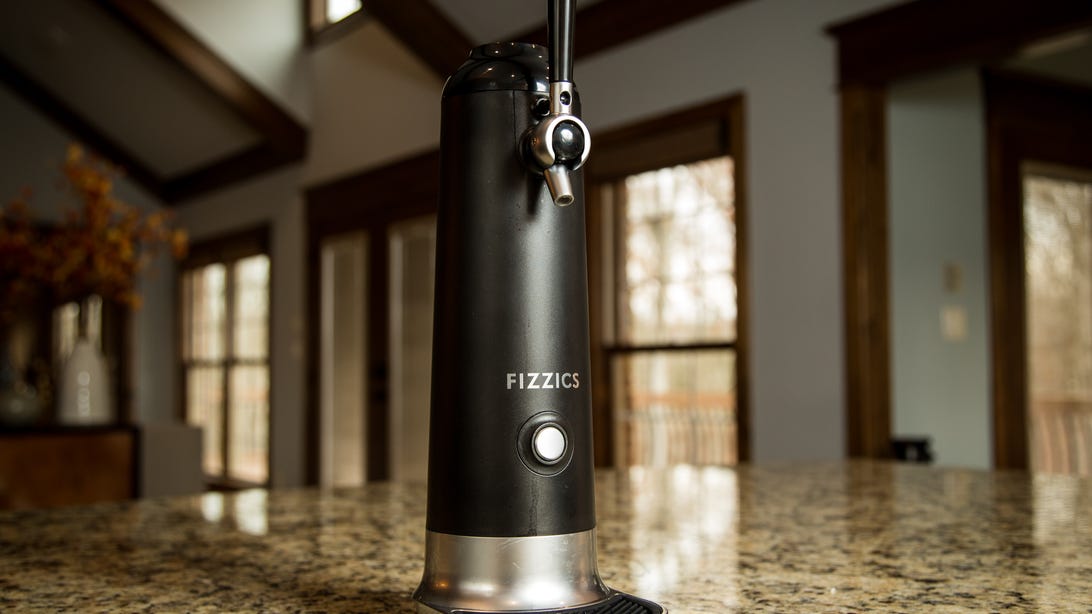Read more of this story at Slashdot.
Ronald.phillips
Shared posts
It's Not Your Imagination. Shopping on Amazon Has Gotten Worse
Matthew Modine's Full Metal Jacket John Wayne Impression Came From Working With Mel Gibson

"Is that you, John Wayne? Is this me?"
It's a recurring line in "Full Metal Jacket," Stanley Kubrick's intense 1987 war meditation as famous for its colorful language and memorable characters as it is for its scrutiny of the Vietnam conflict. The line is first uttered by Matthew Modine's J.T. Davis, a new Marine recruit at Parris Island. Delivered within a full-throated impersonation of the Golden Age movie star, the cheeky statement lands Davis on the radar of sadistic drill instructor Gunnery Sergeant Hartman (R. Lee Ermey), earning the quipster the nickname "Pvt. Joker" for the bulk of the movie. See the moment here, and enjoy the subsequent cornucopia of curses that flows from the D.I.'s lips.
Speaking to The Hollywood Reporter, the "Pacific Heights" star unearths the story behind Private Joker's drawling John Wayne impression which, it turns out, was cultivated three years before stepping onto Kubrick's set.
Modine grew up in and around both Utah and southern California, the son of a drive-in theater manager. "Our homes typically were next to the drive-in properties," he tells the Wall Street Journal, "and every night was movie night." Of the movies playing at the outdoor theaters, John Wayne's westerns were frequently shown; it would familiarize the future actor with the gruff cowboy aesthetic that would come to characterize "The Duke." Anyone who's watched "The Cowboys" or the Oscar-nominated "True Grit" knows Wayne's iconic delivery: low, slow, and more legato than staccato. It's a sound that, according to Modine, co-star Mel Gibson came amusingly close to as he learned the nuances of an American accent on the set of a romantic drama.
The Key, Apparently: Slow Down An Australian Accent

"Mrs. Soffel" is something of a Bonnie-and-Clyde riff; it's the true story of convicted robbers Jack and Ed Biddle's escape from a Pittsburgh jail, with the aid of the warden's wife of the title name, played by a feverish Diane Keaton. Gillian Armstrong's 1984 period drama showcases powerful performances by a fairly green Modine and a baby-faced Mel Gibson as the Brothers Biddle; the New York-born, Aussie-raised Gibson was in between "Mad Max" installments and had already gained fame in Peter Weir's 1981 WWI drama "Gallipoli." "Mrs. Soffel" would be Gibson's second American feature after Mark Rydell's "The River" and as such, required a dialect coach to hammer down the North American sound of the condemned Ed Biddle. Modine explains to THR how The Duke emerged from that production:
"I'd done a movie with Mel Gibson called 'Mrs. Soffel,' one of the early movies of my career. And since Mel had quite a heavy Australian accent and had to speak like he was an American, the dialect coach would work with him in slowing him down. And in the process of listening to him learn to speak like an American and then us taking classes together so that we'd sound like brothers, Mel would often sound like John Wayne. So I learned how to do a John Wayne impersonation when I was working on 'Mrs. Soffel,' working with the dialect coach and listening to Mel Gibson learn to speak like an American."
Gibson's deliberate, husky delivery takes on almost a dreamy quality in the film (all the better to seduce the warden's wife with). By the time Modine carries it to "Full Metal Jacket," he successfully translates the unintentional Duke impersonation into an intentional one, with unforgettable results.
Read this next: The Best Movies Of 2022 So Far
The post Matthew Modine's Full Metal Jacket John Wayne Impression Came From Working With Mel Gibson appeared first on /Film.
Is Everyone Still Getting Remote Work Wrong?
Read more of this story at Slashdot.
Every Mia Goth Movie, Ranked Worst To Best

It's astounding how quickly Mia Goth has cemented herself in popular culture as not just an incredibly talented actress, but one with an intuitive sense of what projects suit her best. The London-born actress, who made her feature film debut back in 2013 with Lars von Trier's "Nymphomaniac," has become a staple of arthouse drama, thriller, and horror genre cinema. Her ability to channel both syrupy sweetness and malevolent darkness makes her a versatile addition to any film, traits that brought her into the mainstream with Ti West's "X" and prequel "Pearl" in 2022.
With her star set to shine brighter than ever following the wildly successful release of "Pearl," we've ranked all 12 feature films starring Mia Goth from worst to best. Frankly, it's a testament to her taste as a performer that we'd still recommend checking them all out, even if some films are more enjoyable than others.
Nymphomaniac (2013)

Considering the diverse and prolific caliber of Mia Goth's acting roles to date, it's only fitting that her feature film debut was for one of modern cinema's most controversial auteurs. Starring as "P" in the second chapter of Lars von Trier's "Nymphomaniac," Goth's first big-screen role is one of a few notable bright spots in this exhaustingly provocative cinematic wink at the audience.
Charlotte Gainsbourg leads the film as Joe, a self-proclaimed nymphomaniac rescued by virginal bachelor Seligman (Stellan Skarsgård) after she's viciously beaten and left for dead near his apartment. Across the film's two volumes, Joe recounts her tumultuous and x-rated life story to Seligman, her polar opposite in just about every sense. Reflecting on foundational experiences, explicit encounters, and the great unraveling of the self that has led her to the present day, "Nymphomaniac" has the foundations of a compelling narrative.
Unfortunately, it's dragged down by the weight of its second chapter, where its philosophizing wears thin. There are certainly elements of merit: Uma Thurman absolutely kills it as an outraged wife who walks in on one of Joe's affairs, and von Trier's experimentation with digitally grafting the cast onto real, unsimulated sex acts is entertaining at the very least. But aside from its explicit novelty and some stand-out performances — including Goth as Joe's young sexual protégé — von Trier falls short of the cohesive impact left by previous efforts like "Antichrist" and "Melancholia."
Everest (2015)

Of all the films on our list, "Everest" is probably the most accessible and ordinary. That's not an insult; it just goes to show the diverse and challenging range of projects that Mia Goth has taken on in her short but astounding career so far. And even if it's quite possibly the shortest on-screen appearance she's ever had (as Robin Wright's Texan daughter), you could find much worse ways to spend a chilly winter evening in.
Based on the 1996 real-life disaster involving two expedition groups on Mount Everest's slopes, Baltasar Kormákur's "Everest" boasts a star-studded lineup including Jason Clarke, Josh Brolin, Robin Wright, Keira Knightley, Jake Gyllenhaal, Emily Watson, and Elizabeth Debicki. It's a crowded cast, but that mass of climbers is one of several major contributing factors that led to the severe injury and loss of lives suffered on Everest in May 1996.
There are some heart-wrenching performances here throughout, and for the most part, Kormákur crafts an immersive and convincing depiction of the treacherous peaks of the Himalayas. While it ultimately doesn't land a high spot on our list — there are simply far more ambitious and impactful films in Goth's filmography — it's still a solid retelling of one of humanity's most notable disasters in modern history.
The House (2022)
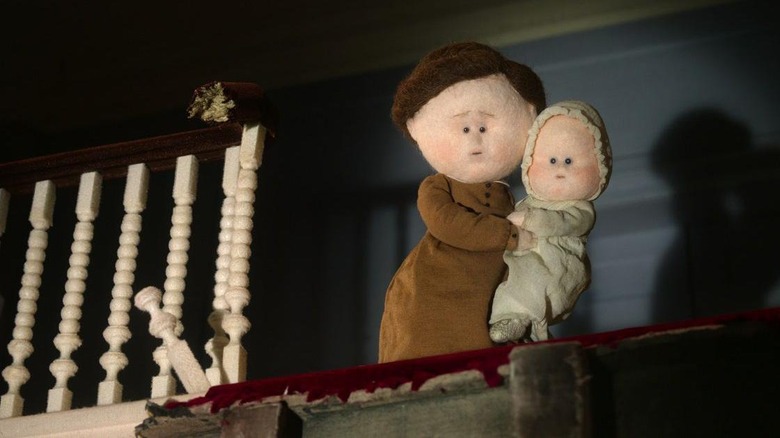
For as much as Netflix's original content (forgive our use of that word) can pale in comparison to the recent offerings from other major streaming services, there are some superb animated series and features to be found there. One such feature is "The House," a stop-motion anthology film from directors Emma De Swaef, Marc James Roels, Niki Lindroth von Bahr, and Paloma Baeza.With a single house serving as the binding motif across different eras and styles of animation, "The House" is a beautifully crafted film that approaches the idea of a home from very different angles. The three segments follow the occupants of the titular home across past, present, and future, spinning tales of temptation and greed, the importance of family and friends, and what it means for a house to truly be a home.
The first segment, which stars Mia Goth as the eldest daughter of a peasant family who finds themselves the occupants of an increasingly labyrinthine mansion, is arguably its strongest. Goth's vocal performance, which is more akin to her famously gentle off-screen speech than usual, contrasts well with the shadowy specters of her family's new home. There's a genius approach to the animation, in which everything appears to be made of felt or cotton — a touch that makes the looming darkness of its story all the more sinister. Overall, "The House" is an entertaining and lovingly animated experience we'd love to see more of.
Marrowbone (2017)
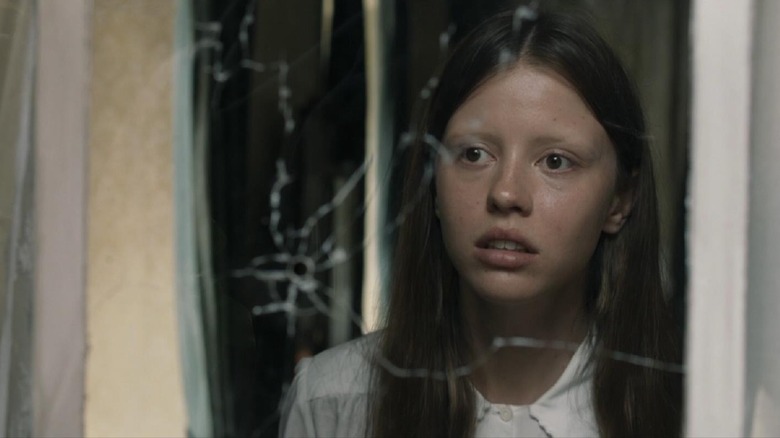
Every once in a while you come across a film that has such a stacked cast you're not sure how it passed you by. That's exactly the case with "Marrowbone" from Spanish writer-director Sergio G. Sánchez, who's perhaps best known for writing the 2007 Gothic horror film "The Orphanage." While it has its issues, "Marrowbone" is a beautifully shot, well-acted Gothic tale that deserves to be on your radar.
In the late 1960s, a young family flees their English home for America in the hopes of escaping the clutches of their abusive father. Soon after, their mother passes away, leaving her four children to fend for themselves. Jack (George McKay) is less than a year from being able to serve as legal guardian to his siblings as long as he can avoid the authorities. Isolated in their rural home with only librarian Allie (Anya Taylor-Joy) to keep them connected to the outside world, the Marrowbone family's conundrum is a sympathetic and compelling one.
Where the film may divide audiences (as it did with critics on release) is the final act, where it takes the narrative in a direction that may not land for everybody. Nonetheless, thanks to charming and spirited performances from a cast including Mia Goth and "Stranger Things" star Charlie Heaton as the middle Marrowbone siblings, the film is still an atmospheric and emotional Gothic tale worth checking out if that sounds up your alley.
If you or someone you know may be the victim of child abuse, please contact the Childhelp National Child Abuse Hotline at 1-800-4-A-Child (1-800-422-4453) or contact their live chat services.
Mayday (2021)

Despite releasing on the precipice of Mia Goth's career breakout and an alluring premise, 2021's surreal action-drama "Mayday" seemed to disappear over the horizon quicker than it deserved. It's a shame, really. Despite stumbling in its execution, Karen Cinorre's directorial debut is an ambitious, dreamy work of cinema.
Grace Van Patten ("Tell Me Lies") stars as Ana, a young woman working at a seaside hotel during a wedding reception. When Ana is assaulted by her boss, she begins to hear a mysterious mayday call, leading her to the kitchen where she finds herself transported to an island seemingly during World War II. There, she meets a group of rebellious female soldiers who lure in passing soldiers with phony emergency broadcasts, slaughtering them from the vantage point of their beached submarine hideout. Although Ana initially enjoys the delirious escapism, her desire to return home is met with resistance from the group of deadly sirens.
Comparisons to Zack Snyder's "Sucker Punch" are inevitable, although the allegorical dreamscape and female-fronted action here are considerably less video-gamey, fetishistic, and blockbuster slick. It does drag in its middle act and doesn't quite manage the impact it has the potential for. However, "Mayday" is undeniably visionary, and the dynamics between the island's inhabitants (Mia Goth, Juliette Lewis, Havana Rose Liu, and French singer Soko) are enjoyable. If anything, give it a shot for Goth's confident, gleefully murderous Marsha.
Emma. (2020)
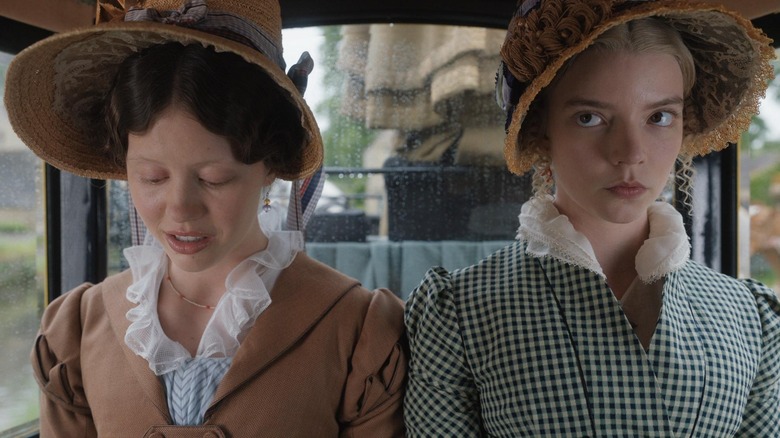
It's certainly not the first time Jane Austen's classic romantic novel "Emma" has been adapted to the screen — far from it. But Autumn de Wilde's 2020 film of the same name, featuring Mia Goth's least typecast role so far, is among the most enjoyable Austen adaptations with its vibration production design, contemporary energy, and charismatic cast.
Emma Woodhouse, played by the ever-talented Anya Taylor-Joy, lives in luxury with her father (Bill Nighy) in early 19th-century England. She gets her kicks from snooping on and manipulating the love lives of her companions while avoiding having one of her own. But Emma's games fold back on her when her new friend Harriet (Mia Goth) and the handsome Mr. Knightley (Johnny Flynn) complicate matters of the heart in ways out of her control.
There's plenty to enjoy here, even if period pieces and/or romantic comedies aren't your usual fare. From the costuming to décor to the mise-en-scène, "Emma." is visual high tea. The screenplay, penned by New Zealand author Eleanor Catton ("The Luminaries"), is brimming with wit and youthful perspective, refreshing it for a new generation by leaning all the way into blunt self-awareness. Also, the cast is practically born for their roles, especially Goth's Harriett, whose aloof sweetness may surprise those used to her darker roles. Fingers crossed she reunites with de Wilde for the director's eventual sophomore feature.
A Cure For Wellness (2016)

Although it landed with a thud at the box office and was generally disliked by critics upon release, we can't help but enjoy Gore Verbinski's delirious horror movie "A Cure for Wellness." After repeated success at the box office with family-friendly outings like the first three "Pirates of the Caribbean" movies, it was inevitable that Verbinski would take the opportunity to delve back into the darker territory he'd previously explored in his 2002 remake of the J-horror classic "The Ring."
In a rare appropriately cast role, Dane DeHaan stars as a young business executive tasked with retrieving the company's CEO from a remote wellness spa in the Swiss Alps. Not long after arriving at the gorgeous facility, he's injured in a car accident and finds himself an unwilling patient of the spa's mysterious director Dr. Heinreich Volmer (Jason Isaacs). Mia Goth also stars as Hannah, one of the good doctor's "special patients" and DeHaan's accomplice in uncovering the mysteries behind Volmer's miracle treatments. While it's not Goth's first time working with dark material, she elevates the film's atmosphere and over-the-top revelations with her dynamic and eerie performance.
It's unfortunate that "A Cure for Wellness" didn't quite hit the mark. It may be bloated and more than a little goofy, but with Verbinski's larger-than-life direction, some utterly entertaining set-pieces, a well-chosen cast, and an old-school Hammer Horror charm writhing under the surface, it's actually worth checking out.
Pearl (2022)
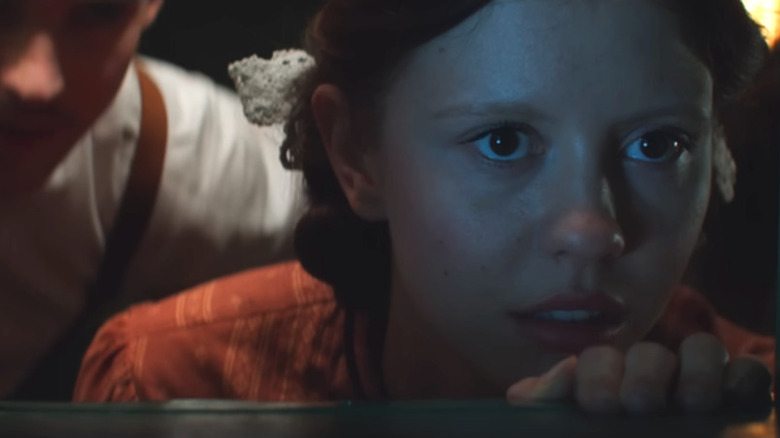
"X" was one of 2022's biggest and best surprises. Ti West's return to the kind of gritty, old-school throwback horror that kicked off his directorial career (in the form of "The House of the Devil") was an instant classic, largely thanks to Mia Goth's fantastic dual roles as the film's protagonist and antagonist. But the blood-covered cherry on top was the revelation that a prequel film had been shot in tandem with "X" and would be released within the same year.
That brings us to "Pearl," which follows the titular character's downward spiral from hopeful starlet to murderous farmer. In addition to her leading role, Goth co-wrote the prequel alongside Ti West, resulting in a sympathetic, more dramatic portrait of the woman we meet in the exploitation gore-fest of "X." With her beloved husband shipped off to the frontlines of WW1, Pearl's dreams of showbiz stardom are stifled by the responsibilities of helping her stern mother and a father disabled by the Spanish flu. Tempted by opportunity's knock, Pearl rebels against the farmstead's burdens — but repressed urges threaten to take it all away.
While it lacks the full impact of "X" in some areas — mostly due to its proximity to the previous film — it stands on its own two feet with its characterization of Pearl, Goth's commanding performance, and a distinctly Technicolor-era aesthetic that doesn't over-do it.
The Survivalist (2015)
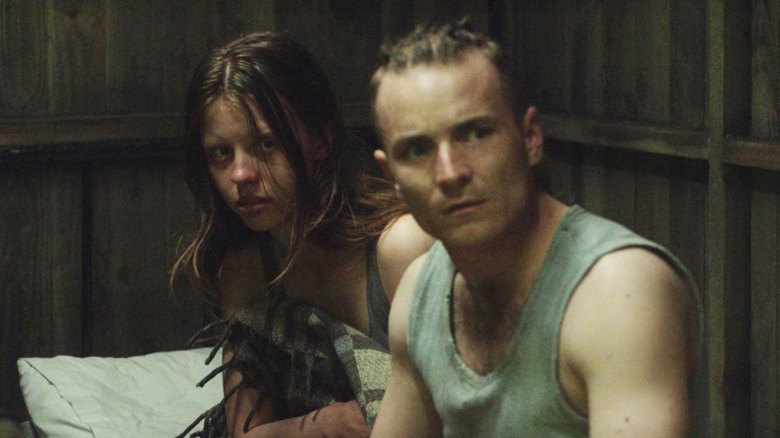
If "The Survivalist" has gone under your radar until now, you're in for a treat. It's one of Mia Goth's earliest on-screen roles, one more emotionally subdued than the likes of "Pearl." But along with top-notch cinematography and atmosphere, it's some of her best work to date.
This bleak but gripping post-apocalyptic drama follows a young man who has made a solitary life in the wilderness after the collapse of society. He's a natural survivor, living off the land and keeping his existence quiet from the potential threat of strangers. That all changes with the unexpected arrival of Kathryn (Olwen Fouéré) and her daughter Milja (Goth), who beg for shelter and supplies from the protagonist. Reluctantly, he bargains with them for mutual benefit, but his decisions will have startling repercussions.
It's a film that should be sought out straight away by fans of Cormac McCarthy's "The Road" and similar post-apocalyptic fiction. Rather than depicting overgrown skyscrapers and scarred landscapes in lavish CGI, "The Survivalist" instead focuses on its morally complex characters and how the desperation to live shapes us. The state of the world is instead implied by the behavior of the characters who live in it, leaving audiences on the edges of their seats rather than with expensive special effects.
High Life (2018)

Claire Denis, the legendary French director behind such films as "Beau Travail" and "Trouble Every Day," made her English-language feature debut in 2018 with the beautiful, contemplative yet utterly disturbing science fiction tale "High Life." While some might find its darkly sexual content challenging, it's a unique and beautifully crafted approach to an often drab and by-the-numbers genre.
Starring Robert Pattinson, Juliette Binoche, Mia Goth, and Outkast's André Benjamin, "High Life" takes place on a space vessel bound for a black hole in the hopes of harnessing its properties for use as an alternative energy source back on Earth. The ship's crew — mostly comprised of prisoners who had been sentenced to execution by the state — are subjected to bizarre sexual experiments by Dr. Dibs (Binoche), who yearns to successfully impregnate and deliver a healthy newborn in space.
Through a non-linear narrative, Denis' film explores the morality underneath the prison system, sexual dynamics, and the complexities of human existence. The casting of Mia Goth alongside Pattinson was inevitable (they are, after all, A24 royalty at this point), and they're perfectly suited to this movie's uncanny blend of touching reflection and taboo horrors. This film won't work for everyone, but we rank it amongst Goth's finest projects.
X (2022)

Ti West has directed numerous films since his modern horror classic "The House of the Devil" back in 2009, but arguably, none have made quite the same impact. That changed with the release of "X" in 2022, marking a return to not only his '70s throwback style of horror filmmaking but the crowd-pleasing thrills and frights as well.
Paying tribute to the likes of "The Texas Chain Saw Massacre" and the adult entertainment industry of the 1970s, "X" is a love letter to the outsiders of cinema in all its forms. A ragtag group of crew and performers rent out a cabin on a rural Southern property to shoot a low-budget porn feature, only to find themselves preyed upon by the locals. It's exactly what it says on the tin, but when you have this kind of morbid glee and production quality in the mix, that's a compliment.
There are some great performances from the cast, especially scream queens Jenna Ortega ("Scream") and Mia Goth — the latter of whom plays an incredible dual role in the vein of Tilda Swinton in 2018's "Suspiria" remake, which she also starred in. There's a lot to enjoy about "X," but it wouldn't land nearly as well without actors who know exactly what kind of movie they're in and are clearly having a great time doing it (even if they're getting butchered in the process).
Suspiria (2018)
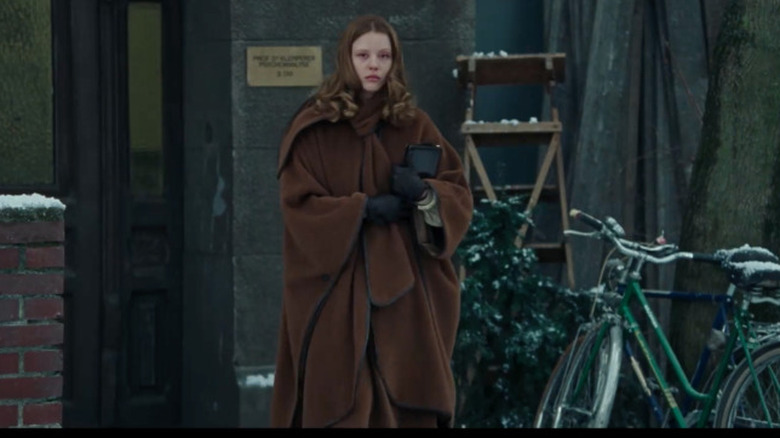
It's understandable that whispers of a Hollywood remake of Dario Argento's Italian horror classic "Suspiria" were met with skepticism and more than a little ire. The original film is an occult fever dream, full of lavish production design and a prog-rock score that's still performed live during screenings to this day. How could anything possibly capture that same magic?
The 2018 reinterpretation by "Call Me by Your Name" director Luca Guadagnino isn't a soulless cash-in on the intellectual property rights as some might have feared. While both films follow a young American woman discovering a coven of witches is behind the dance academy she attends, Guadagnino goes further in the realms of narrative. He weaves an emotionally and politically complex tale while still delivering some of the most aesthetically striking (and horrifying) sequences in modern horror history. It's a true masterpiece in its own right, even if Argento himself really wasn't a fan.
While Mia Goth's supporting role doesn't quite allow for the heights of performance she's capable of, she's the perfect fit as dance student Sara Simms, who assists Susie (Dakota Johnson) in uncovering the truth behind Madame Blanc (Tilda Swinton) and her academy. Given that Guadagnino has a history of re-casting his favorite collaborators on future projects, we'd love to see Goth taking a leading role in his (unlikely to ever manifest) remake of the original follow-up to "Suspiria," "Inferno."
Read this next: The 15 Best Final Girls In Horror Movies Ranked
The post Every Mia Goth Movie, Ranked Worst to Best appeared first on /Film.
Fallout 4 gets a fan expansion, inspired by Fallout: New Vegas’ DLC
Modder ‘Zanthir’ has released a fan expansion for Fallout 4, called A Taste of Blues. Inspired by Fallout: New Vegas Old World Blues DLC, this mod is a must-have for all New Vegas fans. In this mod, you will travel to the X-49 facility, discover the secrets therein, and find some familiar (and some new) … Continue reading Fallout 4 gets a fan expansion, inspired by Fallout: New Vegas’ DLC →
The post Fallout 4 gets a fan expansion, inspired by Fallout: New Vegas’ DLC appeared first on DSOGaming.
Scientists Say Webb Telescope's New Exoplanet Data is 'a Game Changer'
Read more of this story at Slashdot.
CNN: NASA Discovery Reveals There May Have Been Life on Mars
Read more of this story at Slashdot.
Jeff Goldblum Made The Fly A Once-In-A-Lifetime Role For Geena Davis

Not only is Geena Davis remembered and recognized for iconic roles such as "Tootsie," "The Accidental Tourist," "Thelma & Louise," and "A League of Their Own," her humanitarian work has done a great deal for the entertainment industry at large. The Geena Davis Institute on Gender Media has been involved with the Bentonville Film Festival for years now, and Davis recently sat down with Collider from the festival to talk about some of her personal career highlights. Even if we only look at Davis's genre work, films like "Beetlejuice" have left an indelible mark on pop culture. But David Cronenberg's masterful remake of "The Fly" reaches Shakespearean levels of tragedy that are hard to shake even decades later. When Seth Brundle (Jeff Goldblum) invents teleportation and accidentally transports himself and an unfortunate housefly into a second pod, it fuses their DNA together, starting a gruesome transformation. Davis enters in as an ambitious journalist who falls for Brundle and then gets to witness his disgusting demise.
Goldblum and Davis worked together for the first time in "Transylvania 6-5000" but they were officially a couple on the set of "The Fly." When Brundlefly acid vomits and rips its own face off to turn into a giant bug, the tears that Davis sheds aren't just for the character. That's her BOYFRIEND. In that moment, she may have been regretting the fact that Goldblum had helped her get the part. Mercifully, working with Cronenberg turned out to be "a fabulous experience."
'What If You Guys Break Up?'
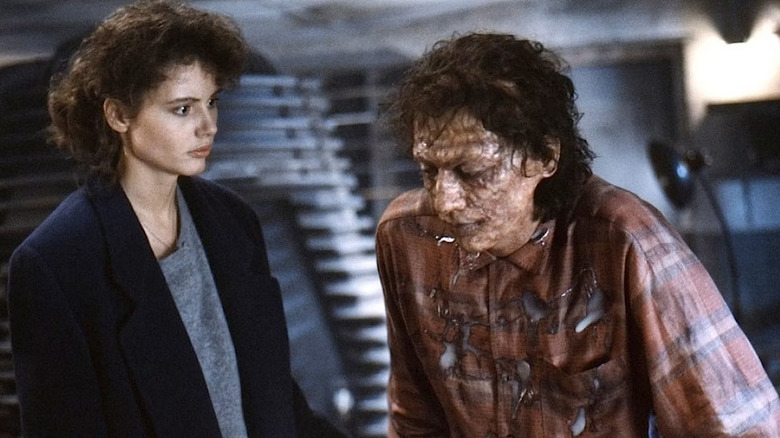
Acting alongside your real-life partner in an innocent romcom could already prove to be a challenge, so imagine Davis and Goldblum working together on what is considered the quintessential body horror film. Cronenberg's unflinching vision for "The Fly" and Davis's dedication to fully immerse herself in the part proved to be a perfect combination of horror and heart. Davis spoke about taking the role originally and the initial reluctance to cast two actors who were actually dating each other (via Collider):
"I got cast because Jeff Goldblum was already cast and we had recently become an item, and he recommended me for the female part, and they were like, 'Oh, well what if you guys break up? That would be a bad idea.' And then I auditioned and they said, 'Okay.'"
Clearly, talent won out over the risk that the couple would decide to part ways halfway through filming. The entire production was a rare experience for Davis and turned out to be extremely rewarding. She continued:
"So the thing about that, which had never happened before or since, but I was acting with my actual real life partner and so we just lived and breathed that movie ever since we got cast. And so it was a wonderful experience. And David Cronenberg is so collaborative and supportive and everything. It was just a fabulous experience."
The reactions of Davis go such a long way to sell the unbelievable practical effects in "The Fly" and gives so much necessary weight and reality to the horrors taking place. Every time she visits Brundlefly's apartment, another phase of the transformation is underway, forcing her to become an unwilling observer. Knowing the two actors were dating sells the dread even more.
Read this next: 14 Remakes That Are Better Than The Original
The post Jeff Goldblum Made The Fly A Once-In-A-Lifetime Role For Geena Davis appeared first on /Film.
A Christmas Mystery 2022 720p WEB h264-TRUFFLE
The post A Christmas Mystery 2022 720p WEB h264-TRUFFLE appeared first on SceneSource.
Quake: Ray Traced
U.S. Bans Chinese Telecom Equipment and Surveillance Cameras Over National Security Risk
The Best Easter Eggs We Found In The Guardians Of The Galaxy Holiday Special

Warning: This article contains spoilers for "The Guardians of the Galaxy Holiday Special."
"The Guardians of the Galaxy Holiday Special" is about Christmas traditions: honoring them, subverting them, and acknowledging they're great for humanity. Beyond the blatant consumerism that accompanies every November and December on Earth is a genuine spirit of giving. That spirit has a killer soundtrack ranging from ancient carols to modern classics by The Pogues. Even some of the most endearing television ever created has centered around the holidays and Christmas, specifically. James Gunn knows and owns all this. His "Holiday Special" is as close to "A Charlie Brown Christmas" as it is to his own "Guardians" films, and the end product is a remarkable tightrope walk between nice and naughty.
Accordingly, "The Guardians of the Galaxy Holiday Special" is crammed with story, much of it centering around Mantis (Pom Klementieff) and a nipples-covered Drax (Dave Bautista) kidnapping Kevin Bacon to be a Christmas gift for Peter Quill (Chris Pratt). Still, Gunn and his production team found room for a few solid Easter eggs and they, like the holidays, are worth celebrating. Here are the best Easter eggs we found in Disney+'s "The Guardians of the Galaxy Holiday Special."
James Gunn And The Old 97's
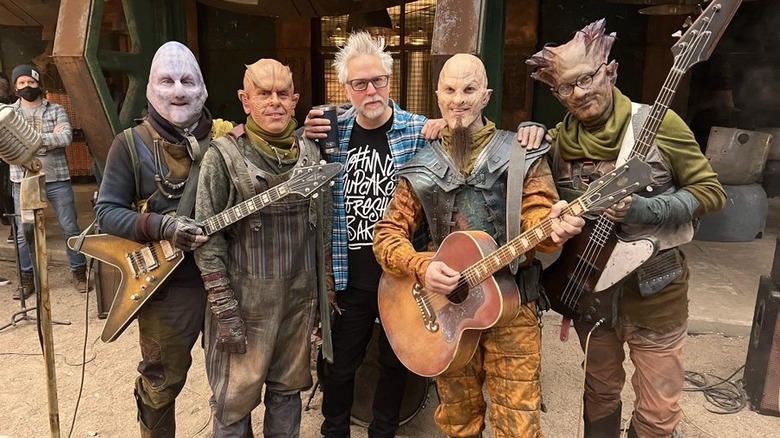
I wish the Old 97's were a traditional Easter egg in "The Guardians of the Galaxy Holiday Special." The cult alternative country band is overdue for mainstream appreciation, one whose discography is as fun and innovative as it is cathartic and moving. The Old 97's are tasked with writing two new Christmas jams for "The Guardians of the Galaxy Holiday Special" and acting for the first time. They crush both tasks equally. Credit to James Gunn and the entire band (Rhett Miller, Murry Hammond, Ken Bethea, Phillip Peeples) for their monumental work.
What most viewers might not realize, though, is that the Old 97's have contributed to James Gunn's filmography before. James Gunn told The Hollywood Reporter, "[The Old 97's have] been my favorite band since the '90s, and I've seen them in concert a billion times. I met [lead vocalist] Rhett Miller in 2005 because I put an Old 97's song at the end of 'Slither,' my first movie. It plays over the end credits, and Rhett and I have stayed in touch ever since then. And so I started writing this song for the beginning [of the special], 'I Don't Know What Christmas Is (But Christmastime Is Here)' ... And finally, I approached Rhett and asked, 'Will you help me write this song? Because I can't do it by myself.' And he said, 'Absolutely.'" That means that Old 97's appearance in "The Guardians of the Galaxy Holiday Special" reinforces the special's themes of found family, and it's not the only casting decision that reflects it either.
Kevin Bacon Calls His Actual Wife, Kyra Sedgwick

Kevin Bacon's appearance as himself in the Marvel Cinematic Universe lives up to any wild expectations audiences have for it. In just 44-odd minutes, the 64-year-old actor establishes himself as a self-aware comic dynamo who parodies multiple roles from his filmography, drops a purposefully ridiculous British accent, and sings an excellent original Christmas song. Bacon isn't the only member of his family who makes an appearance in the special, though.
When we first see Bacon, he's calling his wife Kyra to let her know that he grabbed all of the Christmas gifts for the kids. The voice of "Kyra" is Bacon's real-life wife Kyra Sedgwick. For those who don't know, Sedgwick is a deeply accomplished performer in her own right. The New York City native is best known for her role as Brenda Johnson, the titular closer of TNT's long-running series "The Closer," and has appeared in multiple projects with her husband before. (They co-starred on-screen in "The Woodsman" and Sedgwick contributed her voice to Bacon's excellent thriller "Cop Car.") It's a nice Easter egg for fans of either performer, and a casting decision that reinforces the reality of Kevin Bacon as an MCU character.
We Find Out What's Going On With Kingo

Much of "The Guardians of the Galaxy Holiday Special" feels delightfully removed from the MCU. The story is important to the Guardians themselves but has little or no impact on Kang, what's going on with the multiverse, or whatever the Secret Invasion is. Accordingly, there are very few traditional Marvel Easter eggs or ties to the larger Marvel universe over the special's 40-plus minutes. One of the few, however, is a good one.
When Drax and Mantis are stumbling around Hollywood, they find a gay bar to frequent in search of Kevin Bacon. Before they enter, a marquee is visible for a cabaret that's playing on the strip. That show? "Kingo's Christmas." Kingo, of course, is the Eternal played by Kumail Nanjiani in Chloe Zhao's Phase Four epic "Eternals." When we last saw the Bollywood star Kingo, he excused himself from the Eternals interpersonal conflicts — ones that have ramifications for the entire galaxy — and it wasn't clear what he'd be getting up to instead. Thanks to the "Holiday Special," now we know that the answer is "a cabaret of Christmas music." It's a hysterical resolution to one of the more surprising plot points in "Eternals" and a great Easter egg to boot.
The GoBots
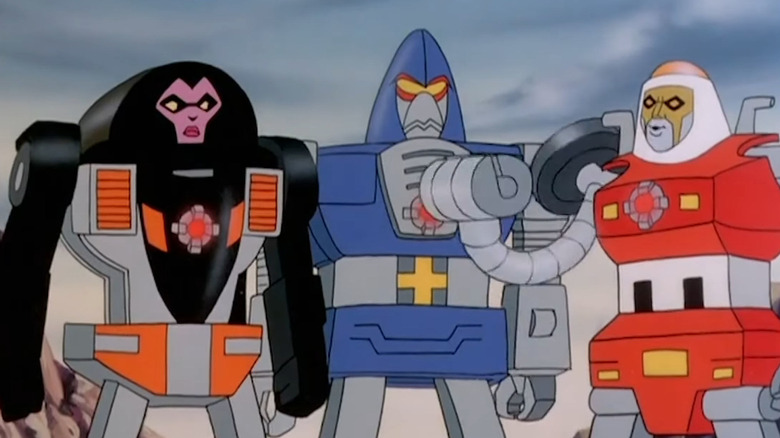
Never underestimate James Gunn's affection for lesser-known comic book characters. In his 2021 film "The Suicide Squad," Gunn trotted out Weasel (Sean Gunn) and made Polka-Dot Man (David Dastmalchian) a compelling and emotionally solvent character. Gunn's HBO Max spinoff series, "Peacemaker," is the bonafide smash nobody saw coming. It's not surprising that "The Guardians of the Galaxy Holiday Special" has deep-cut individuals in it, but the GoBots are an obscure strain of non-Marvel IP, even by James Gunn standards.
For context: When Drax and Mantis arrive in Hollywood to find Kevin Bacon, they stumble upon an area where costumed performers are taking photos with tourists. Many of them are Marvel characters audiences recognize (Captain America, Ant-Man, Captain Marvel, etc.). One is not; it's a man dressed as one of the GoBots. Drax sees him and instantly flies into a rage, one quelled by Mantis. Mantis explains, "GoBots killed his cousin."
So, apparently, the GoBots — which were a Tonka toy line of vehicles that changed into robots and preceded "Transformers" — exist in the MCU and murdered a member of Drax's family. If that wasn't enough, a comic book published by IDW in the year 2018 insinuated that the GoBots invented the Transformers. This would mean that the Transformers and GoBots are potentially all MCU-canon, and while this is highly unlikely, it's the kind of twist that sets Reddit forums on fire and that's hysterical enough to make this a good and notable Easter egg.
Ares Exists In The MCU?
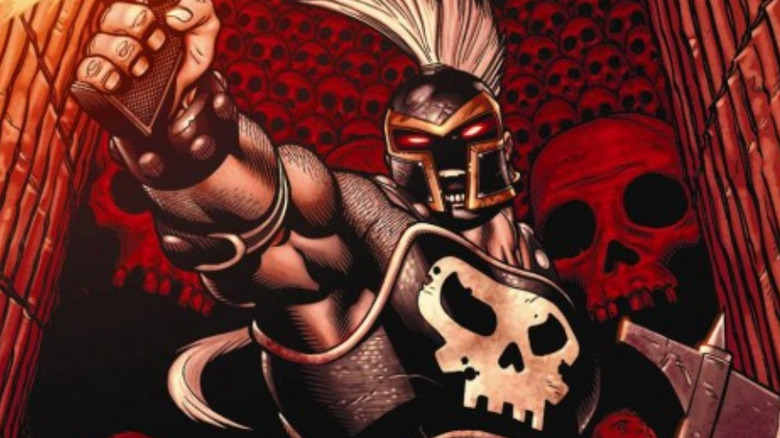
"Thor: Love and Thunder" confirmed the existence of many ancient gods in the MCU. Audiences learned that Zeus (Russell Crowe) is petty and pretty much over Earth 616's problems. During the film's post-credit sequence, Zeus dispatched Hercules (Brett Goldstein) to put a hurting on Thor (Chris Hemsworth) since he, Valkyrie (Tessa Thompson), and Jane Foster (Natalie Portman) embarrassed Zeus by stealing his thunderbolt. It's not surprising that the MCU would be full of gods we haven't met yet.
That doesn't mean that "The Guardians of the Galaxy Holiday Special" potentially confirming Ares' existence when a tourist refers to Drax (Dave Bautista) as the "god of war" isn't a fun, potentially thrilling Easter egg. In Marvel Comics lore, Ares is a member of the Olympians. He's also one of Zeus's sons. In terms of temperament, though, Ares is closer to Loki than the God of Thunder. Ares attempted to take over Olympus on multiple occasions and is generally villainous and a schemer on every conceivable level. He would be a compelling addition to the Marvel Cinematic Universe.
There's another possibility where this reference is concerned though. Drax's massive build and shaved head bear an aesthetic resemblance to Kratos, the protagonist of the "God of War" video game series. It could be that the tourists who call Drax the "god of war" are referring to him and not Ares. Either way, it's a throwaway line that yields canon-enhancing comedy gold.
The Cast Includes Multiple Members Of James Gunn's Family

That same sequence isn't just notable for the GoBots. James Gunn has always cast friends and family in fun or notable roles. Sean Gunn, James Gunn's brother, reprises his role as Kraglin Obfonteri here, and he's not the only Gunn who shows up in the special. When Mantis and Drax get roped into taking photos with tourists because they are attired like performers dressed as superheroes, a family rushes to get a snapshot with them. The mother of this family is played by Michelle Gunn, who is James Gunn's sister-in-law.
She's not the only interesting bit of casting in the sequence. A performer dressed who's as a solid-gold living statue is played by Don McLeod. This appears to be the same Don McLeod who played serial killer T.C. Quist in 1981's "The Howling," Joe Dante's legendary horror film about a mysterious colony where werewolves exist. James Gunn cut his teeth making barebones horror movies, so McLeod's presence in the movie, however minimal, feels like a treat for eagle-eyed viewers. Finally, Flula Borg — who stole scenes as Javelin in James Gunn's "The Suicide Squad" — makes a brief but chuckle-inducing appearance as a bartender at a gay bar.
Drax And Mantis Use A Star Map To Visit Real-Life, Now MCU-Canon Celebrities

Following a joyous drinking session at the previously mentioned gay bar, Drax and Mantis are inebriated and farther behind on their quest to find Kevin Bacon than anticipated. Luckily, a shifty woman (Rusty Schwimmer) sells them a star map for 40 bucks. An illustrated map then flies across the screen, showing Mantis and Drax's journey to Kevin Bacon's abode. They stop at, in order, Olivia Wilde, Queen Latifah, John Cena, Arnold Schwarzenegger, and Topher Grace's homes before they reach Mr. Bacon.
There are a lot of fun nuggets to unpack here. For one, Bacon's house is the sixth stop on Drax and Mantis's star map journey. That means they are technically six degrees from Kevin Bacon when they begin their L.A.-based search. For another, it makes Wilde, Latifah, Cena, Schwarzenegger, and Grace all Earth 616 MCU canon. That creates no shortage of narrative wrinkles (if John Cena is MCU-canon, does that mean the DCEU James Gunn now oversees is also Marvel canon? More on that in a bit), but it's also an eclectic and fun arrangement of actors in its own right. If the next five "Guardians" holiday specials are deleted scenes of Mantis and Drax's encounters with these performers, audiences could do far worse.
Kevin Bacon Is Watching Santa Claus Conquers The Martians Before He Gets Kidnapped
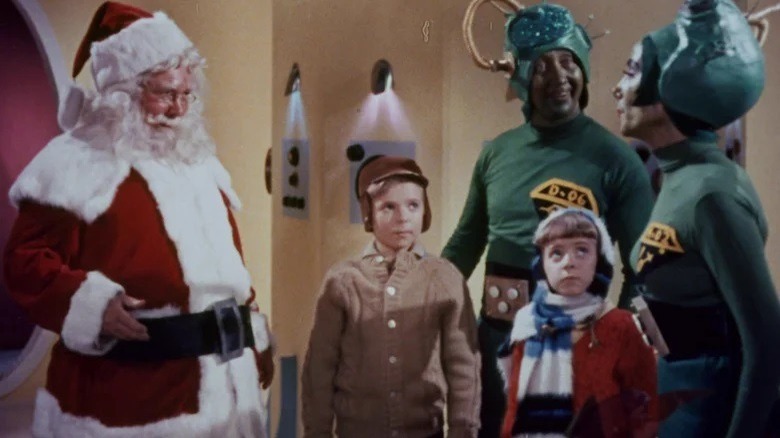
There's no shortage of great Christmas horror movies. There are, sadly, far fewer sci-fi and Christmas crossovers. "The Guardians of the Galaxy Holiday Special" is now one of them, and "Santa Claus Conquers the Martians," an inexplicably real movie directed by Nicholas Webster in 1964, is another.
I am so thrilled to report that "Santa Claus Conquers the Martians" is almost exactly what it sounds like. Jolly ol' Saint Nick (John Call) is abducted by residents of Mars because they've determined their children need fun and freedom to evolve their stymied development. Santa changes martian culture; all are overjoyed. If this sounds insane, rest assured that it is. "Santa Claus Conquers the Martians" is an ode to the power of free thinking, one born of the radical 1960s and all the better for it. It's a very bizarre blast.
Fittingly, it's the movie that's playing on Kevin Bacon's TV screen seconds before the actor gets kidnapped by extraterrestrials. The use of "Santa Claus Conquers the Martians" is more than a cheeky reference, though. Drax and Mantis are kidnapping Kevin Bacon to break Peter Quill out of his self-imposed sad stasis. That's an issue of needing Christmas to evolve. What's more, Kevin Bacon's arrival in Knowhere transforms the entire city into a proverbial winter wonderland. Drax and Mantis don't just kidnap Kevin Bacon the way the martians did Santa Claus; Kevin Bacon transforms Peter Quill and Knowhere like Saint Nick did with a whole alien race. It's a clever, thematically resonant Easter egg.
Henry Winkler And Batman Are MCU Canon
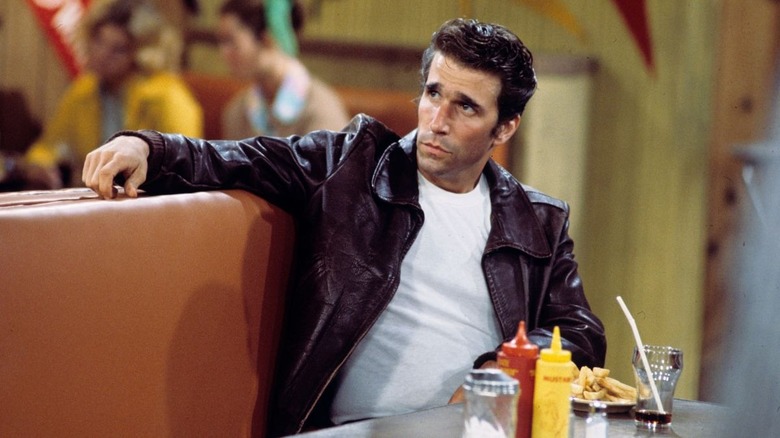
Once Kevin Bacon is kidnapped and whisked to Knowhere, you would think there'd be fewer Easter eggs to find in "The Guardians of the Galaxy Holiday Special." You'd be wrong. During an impromptu conversation with Drax and Mantis, Mantis asks Kevin Bacon if he knows The Fonz. Mantis is referring to the legendary character played by Henry Winkler on the television show "Happy Days." Kevin Bacon confirms that, yes, he knows Henry Winkler and that Henry Winkler is a lovely man. He goes on to confirm the existence of Batman, but only as a character who appears in movies.
The latter point isn't particularly shocking since "Eternals" also contained a massive DCEU reference. But, still, this raises a ton of brain-melting questions. Henry Winkler recently appeared in the DCEU project "Black Adam." Does this mean that the DCEU we're watching in our reality is the same one occupied by the characters of the MCU? (The "She-Hulk" finale would suggest that, yes, this is the case.) If that's true, do DC movies simply exist as fictional tales about superheroes despite the fact that there are a ton of real, actual Marvel superheroes going about their business each and every day? Does a movie like "Black Adam" feel far less fantastical and silly in a world where The Blip has happened?
In fairness, "Black Adam" would be silly in any permutation across the multiverse. But James Gunn playing fast and loose with the reality of who actors are and what they do in the MCU opens the gateway to a ton of meta-questions and future Easter eggs to come.
Taserface Gets A Christmas Gift
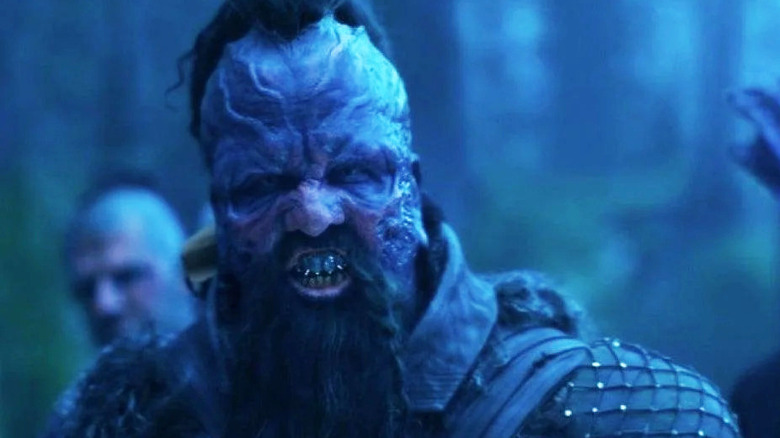
Poor Taserface (Chris Sullivan). Taserface exists to get mocked and bested by Rocket (Bradley Cooper). His name is literally "Taserface," which feels appropriate, and he is a punching bag for both an anthropomorphic raccoon and the Ravagers at large. If there can be justice for Barb on "Stranger Things," surely there can be justice for a man whose face looks tasered to shreds?
"The Guardians of the Galaxy Holiday Special" gives Taserface his due. During its heart-shredding conclusion, the audience learns that Yandu didn't actually smash Peter's Christmas tree to bits and leave it at that. He corrected his Scrooge-like ways and hooked the Ravagers and Peter up with holiday gifts. Peter's gift, crucially, is a set of blasters that he will use in both "Guardians" movies. Even more movingly, though, is a gift revealed when Peter retrieves his gift from the pile. There is a tiny gift below it, bearing the inscription "Tazr Face."
Taserface, like all of us, is deserving of love. That's the thesis of "The Guardians of the Galaxy Holiday Special." No matter how cynical we are about the holidays or what family we find ourselves with on December 25th, Christmas offers one day of the year when kindness is the assumed language of human communication. That is worth celebrating no matter what. James Gunn's special does so through its main story and Easter eggs alike. That makes it worthy of repeat viewings, no matter what you're looking for.
Read this next: The Most Powerful Aliens In The MCU Ranked
The post The Best Easter Eggs We Found in The Guardians of The Galaxy Holiday Special appeared first on /Film.
The Guardians Of The Galaxy Holiday Special Finds A Way To Expand The MCU's Most Heart-Shattering Relationship
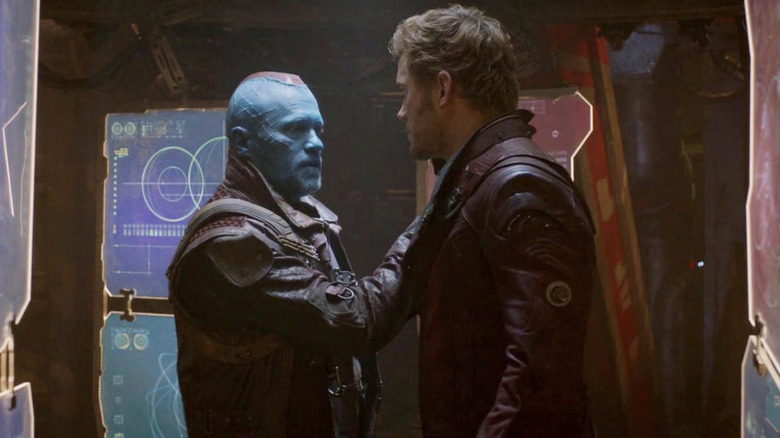
This post contains spoilers for "The Guardians of the Galaxy Holiday Special."
Michael Rooker has been James Gunn's secret weapon throughout the course of his filmmaking career. Rooker has appeared in just about every film Gunn has ever made, so fans were shocked when his character, Yondu, died at the end of "Guardians of the Galaxy Vol. 2." The tough-love parental figure of Peter Quill aka Star-Lord (Chris Pratt) was an immediate fan-favorite, and his declaration of, "I'm Mary Poppins, y'all!" has become an all-time great line in the Marvel Cinematic Universe. Alas, Gunn confirmed that Yondu is dead, dead, and will sadly not be returning for the upcoming "Guardians of the Galaxy Vol. 3."
So imagine our surprise when "The Guardians of the Galaxy Holiday Special" contained some rotoscope-animated vignettes featuring Yondu as told through the perspective of Kraglin (Sean Gunn). Rather than opt for a standard flashback, Gunn is utilizing one of the most common Christmas-special tropes by interspersing animation throughout the live-action special. It gives a quaint, storybook touch, and is a perfect fit for a story centered on trying to give Quill the best possible Christmas.
Rooker returns to voice the character, and the story centers on a memory of Christmas past, with Yondu trying his hardest to be a good father figure and yet again, missing the mark. The animation also works to the special's benefit, as watching a live-action Rooker reprimand a child actor as young Peter Quill would have felt really heavy compared to the light-hearted nature of the rest of the story. Gunn found a way to expand their beautiful, complicated relationship, and "The Guardians of the Galaxy Holiday Special" is better for it.
'He May Have Been Your Father, Boy, But He Wasn't Your Daddy.'
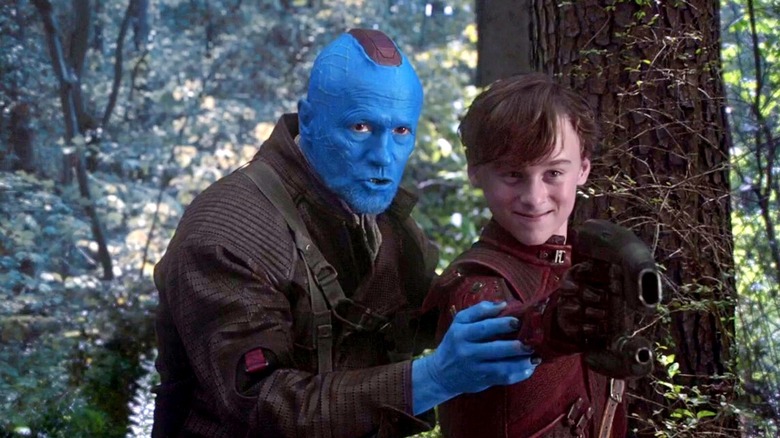
As we learned from "Guardians of the Galaxy" and "Guardians of the Galaxy Vol. 2," the harda** known as Yondu was actually a life-saving sweetheart. He had abducted a young Peter Quill after the death of his mother and elected to raise Peter and protect him from his father, Ego (Kurt Russell), and the other Ravagers. The problem, of course, is that Yondu was never the most emotionally available father figure, and Quill grew resentful and distanced from him. As tough as he was on Quill, this was his warped way of showing love. He's like Dr. Perry Cox from "Scrubs," but, you know, also a Centaurian leader of an exiled faction of the Ravagers.
Following the destruction of Ego's planet in "Vol 2," Yondu flies away with Peter and tells him that the best decision he ever made was taking him under his wing. Always one to put his money where his mouth is, Yondu proves it by giving him the last space suit, sacrificing himself in order to allow Peter to survive. Quill's heartbroken and horrified reaction to his daddy's death is arguably the strongest performance of Chris Pratt's career, and one of the most painful moments in the entirety of the MCU. Peter then acknowledges Yondu as his "true father" at his funeral, finally accepting that despite his flaws, Yondu really did love him.
Merry Christmas, Yondu
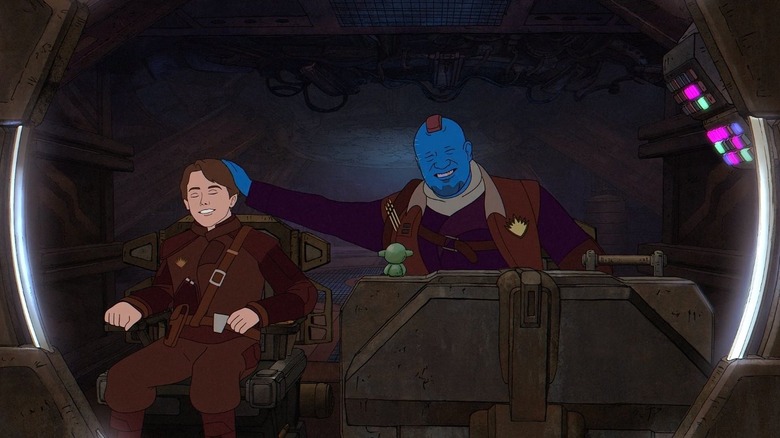
The story of Yondu and young Peter at Christmas is told from two perspectives, Kraglin's (Sean Gunn) and Peter's own. Kraglin tells Mantis (Pom Klementieff) that when Peter was young, Yondu dismissed his desire to celebrate Christmas as he had on Earth, which is what sets her off on a mission to give Peter the best Christmas ever (as she's also his half-sister and feels a sense of sibling obligation) to bring him some holiday cheer. Kraglin only knows part of the story, so his retelling paints Yondu as a cruel and contemptuous jerk, which, to be honest, is not a stretch for Yondu. Less than two minutes in, he's already mocking Peter's makeshift Christmas tree and slapping away presents by saying, "What a Ravager gets, he works for. We ain't about no damn handouts!"
However, Peter knows the full story. After throwing all of the Christmas accouterments in the trash, Yondo came across the present Peter had wrapped for him. Inside he found a little green alien figure, which he promptly put on the dashboard of his ship. If you recall, Yondo's ship in the previous "Guardians of the Galaxy" films was always adorned with little trinkets, implying that they were either years' worth of figures gifted by Peter, or the continuation of a collection that all started with Peter's Christmas present. Despite his initial annoyance, Yondu gave Peter a gift as well ... the quad blasters that would become Star-Lord's primary weapon. As he recounts the story to Mantis, she utters, "That's so sweet." Peter can only respond with the matter-of-fact confirmation, "That's Yondu."
I'M NOT CRYING, YOU'RE CRYING!
Read this next: Disturbing Comic Book Moments The MCU Will Never Show You
The post The Guardians of the Galaxy Holiday Special Finds a Way to Expand the MCU's Most Heart-Shattering Relationship appeared first on /Film.
Justin Long Doesn't Mind Being The Guy Who Always Dies
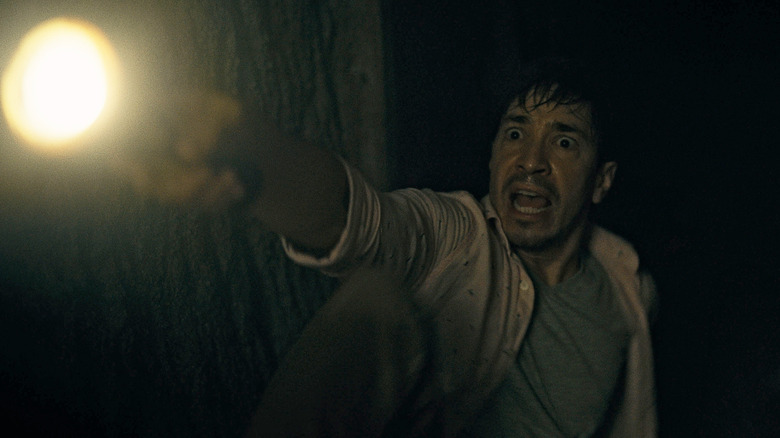
In the world of fiction, every character serves a purpose. For some unlucky characters, their only purpose in the narrative is to die.
These characters are sometimes known as "Redshirts," a term coined by "Star Trek" fans used to refer to the unfortunate ensigns who'd be sent along on a mission with the main cast members, their inevitable death just a plot device to raise the stakes of the episode. Death is a commonly used trope in film and television because it's a common experience in real life. A character's death can serve many purposes, whether it be illustrating the danger and severity of a situation or forcing another character to undergo change and growth. It works as a narrative tool, and so writers use it often.
It makes sense, then, that in Hollywood, you start to see some actors pushed into the Redshirt role more often than others. Actors like Sean Bean have gained a reputation for always dying in any movie or TV show they star in (possible spoilers for anything from Sean Bean's filmography). In the realm of horror movies, a Sean Bean-level career Redshirt seems to be emerging in Justin Long, who finds himself dying brutally in those movies more often than not. And according to a recent Vulture interview, Long doesn't exactly mind biting the dust over and over.
Caught In A Deathloop

In the horror genre, you'll find much of the time that almost everybody's a Redshirt, and not just because of all the blood. In stories where grisly deaths are often the main events driving the plot, you'll often see most, if not all, of the cast meeting brutal ends in service of the main story.
While many may remember Justin Long from fun comedies like "Dodgeball," or even Apple's famous Mac vs. PC series of advertisements, he's also been a horror movie staple since his prominent role in "Jeepers Creepers," a film unfortunately made by an actual real-life monster. Ever since that fateful role, a pattern of Long failing to survive the films' runtimes seems to have emerged.
In the Vulture interview, Long addressed his tendency to buy the farm in most of his horror appearances:
"There was a thing going around, a meme during the pandemic, where it was a bunch of characters I played, and it said, 'Which version of Justin Long are you?' — It was 'Jeepers Creepers,' 'Tusk.' That was the first time I realized that I have met a lot of unfortunate endings."
While I could imagine some people would tire of never being the lone survivor of these kinds of movies, it doesn't seem to bother Long very much. Not only has it allowed him to develop the perfect horror movie scream, but he expects there'll be some karmic rewards for his on-screen suffering.
Dying His Way Into The Hearts Of Millions
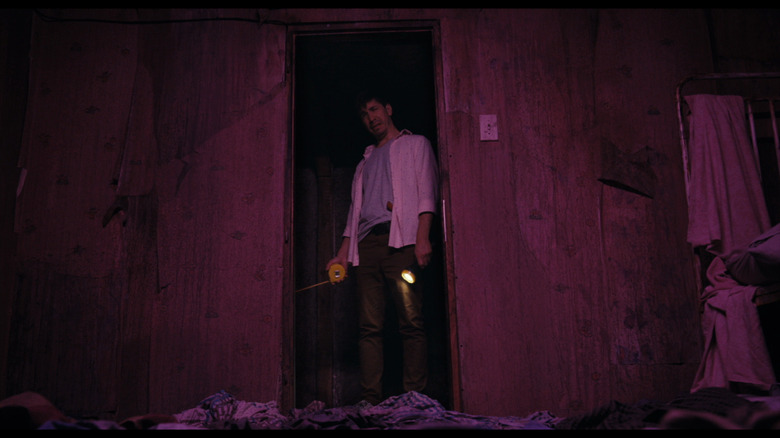
Justin Long has also appeared in a handful of other horror and horror-adjacent films without dying, most prominently in the Sam Raimi film "Drag Me To Hell." Then again, being left alone with a cursed button after watching your fiance get sucked into the depths of Hell before your very eyes isn't exactly an ideal survival situation. Nevertheless, while Long died in countless horrific fashions in films, the tragic ends Long comes to in films are something he enjoys, as he said in the Vulture interview:
"Yeah, I guess my characters have had bad luck, which is fun for me. I'm a horror fan. To be in an audience of equally excited and passionate horror fans at Comic-Con and to hear them applaud my death — I know this sounds strange, but it was oddly thrilling for me. It meant that they were invested and I did my job. That his character was truly deplorable and deserving of a pretty rough ending."
With the critically acclaimed "Barbarian" as the latest horror flick under his belt, Long seems to be well on his way to a royal place in the pantheon of horror movie casualties. He may not always survive to the end credits, but thanks to his numerous appearances in the genre, he's become an undeniable scream king.
Read this next: The Saddest Character Deaths In Horror History
The post Justin Long Doesn't Mind Being The Guy Who Always Dies appeared first on /Film.
Lewis Tan Hints That Shatterstar Might Return (Somehow) In Deadpool 3
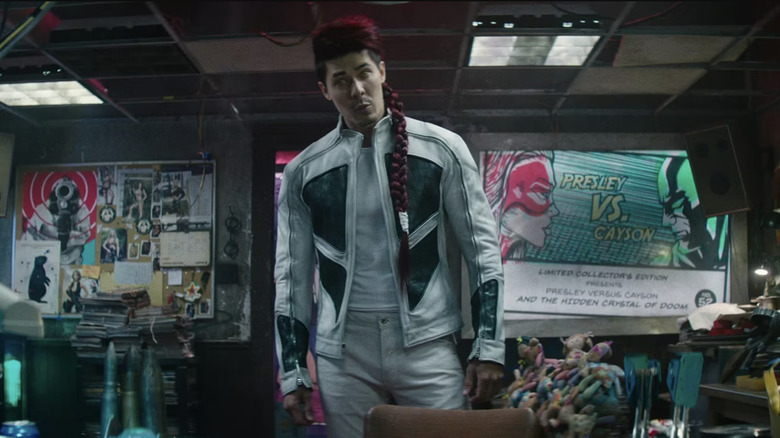
Lewis Tan, the actor who played Cole Young in the live-action "Mortal Kombat" adaptation and the mutant superhero Shatterstar in "Deadpool 2" has been tweeting little emoji teasers for the last few months regarding "Deadpool 3," sparking rumors that Shatterstar will appear in the upcoming film due out in 2024. An actor confirming or teasing an appearance in an upcoming superhero film is nothing new, but Tan's tweet is especially curious, considering Shatterstar fell into the rotating blades of a helicopter and splattered his green, alien blood all over the place. Shatterstar is dead, done-zo, and shredded to bits ... or so we thought.
The rumors started after Hugh Jackman was announced as returning to play Wolverine in the film, as Tan replied with some emojis indicating "Deadpool 2" was not the last we'd seen of him. Of course, he could always be trolling as actors are known to do, but after today's additional tease on Twitter, it's starting to seem more and more likely that Shatterstar will somehow return for "Deadpool 3."
👽⚔️💀💩 #deadpool3
— Lewis Tan (@TheLewisTan) November 25, 2022
Tan had been trying to break into the world of superheroes for quite some time, having almost landed the role of the titular "Iron Fist" for Netflix. Thanks to his background in stunt performance and martial arts, Tan has the skills to play a superhero, which he was finally able to do with Rusty aka Shatterstar. His gruesome death in "Deadpool 2" looked to be the last of the character, but after his breakthrough performance in "Mortal Kombat" and the Wu Assassins sequel "Fistful of Vengeance," bringing back Tan wouldn't be a bad idea for "Deadpool 3."
But just how will they bring this dead alien back to life?
Multiverse? X-Men Powers? Magic?

It's not completely out of the realm of possibility for characters to come back from the dead in the world of Marvel, after all, that's the entire plot of "Avengers: Endgame." As "Deadpool 2" wasn't technically part of the Marvel Cinematic Universe, the return of Shatterstar in "Deadpool 3" might be the start of how the characters will be incorporated into the MCU. The appearance of Wolverine is already a start at getting the "X-Men" characters involved following Disney's acquisition of 20th Century Studios, so it wouldn't be impossible for one of the fellow mutants to use their powers to bring him back. Deadpool used Cable's time-traveling device in "Deadpool 2" to prevent some deaths, and while we didn't actually see Shatterstar revived, there's a Ryan Reynolds monologue about "off-screen events" waiting to happen.
Given the MCU's current obsession with the multiverse, there's always the chance that "Deadpool 3" takes place in a separate multiverse from "Deadpool 2," which would be a pretty easy allowance for Shatterstar's survival and the paths crossing of Deadpool and Wolverine. Or, perhaps, his claim of being an extraterrestrial from the planet Mojoworld and superior to "normal" humans in all ways was true, and there's some alien ... magic ... or something able to put him back together. Regardless of how they pull it off, neither Marvel nor 20th Century Studios have confirmed his appearance, so we'll just have to keep deciphering tweets until the film comes out in 2024.
Read this next: 9 Filmmakers Who Should Be Given Free Rein In The MCU
The post Lewis Tan Hints That Shatterstar Might Return (Somehow) In Deadpool 3 appeared first on /Film.
Geoffrey Rush Doesn't See His Return To The Screen As A Career 'Comeback'

"Don't call it a comeback, I've been here for years." It's an LL Cool J lyric but it applies to one Geoffrey Rush, renowned Australian stage and screen actor. One of the few people who have earned an Academy Award, a Primetime Emmy, and a Tony Award, Rush's resume is extensive and varied.
Following an early career on the stage with the Queensland Theater Company (onstage over his career, he has played Horatio, Figaro, and King Lear, among others), Rush gained universal acclaim in a breakthrough performance in 1996 with "Shine," snagging that Best Actor Oscar. Roles of great gravitas would further cement his fame, like that of sneaky spymaster Sir Francis Walsingham in Shekhar Kapur's 1998 drama "Elizabeth" and the militant Javert in Bille August's 1998 film adaptation of "Les Miserables." Rush has also kept critics on their toes with oddball roles like that of Stephen Price (a fantastic nod to Vincent Price) in the 1999 remake of "The House on Haunted Hill." The kiddies even know him as Barbarossa in the "Pirates of the Caribbean" movies and the voice of Nigel the Pelican in "Finding Nemo."
Starting in 2017, Rush became involved in a lengthy defamation suit against Australian tabloid The Daily Telegraph, which published an article alleging that he had acted inappropriately toward a co-star on one of his theatrical projects. In 2019, Rush won a $2.9 million judgement against the outlet and its publisher Nationwide News. The ruling was upheld on appeal the following year.
Rush is now set to return to the big screen in the upcoming "Raised Eyebrows," a Groucho Marx biopic based on Steve Stoliar's 1996 book "Raised Eyebrows: My Years Inside Groucho's House." However, the actor would prefer not to think of the film as his comeback vehicle.
'I Don't Want To See It In That Way'

Set to be helmed by "The Messenger" director Oren Moverman, "Raised Eyebrows" chronicles the final years of Groucho Marx's life. It's an intimate portrait of the vaudeville performer and star of the screen, stage, and television from the perspective of a young fan who worked as his secretary. The film will also star Sienna Miller and Charlie Plummer.
Speaking with Deadline, Geoffrey Rush acknowledged his hiatus, but said he doesn't see this as a comeback. As he pointed out, he actually boarded "Raised Eyebrows" prior to the pandemic:
"I'm coming back to working, but I don't want to see it in that way. I signed on for this film in August 2020. That was what happened with 'Shine.' I trod water for three years before it was made. You go, 'Hope this idea doesn't fade or go off the boil.' I've struck up an amazing rapport with Oren Moverman. We've just Zoomed a lot, talked about Groucho, and he always says, 'If you have any ideas let me know.'"
The "Quills" actor added that multiple other film offers have come his way since his defamation case. Saved for "Raised Eyebrows," though, he felt they weren't right for him:
"Everyone thinks my career was over after that case, but I got offered roles, but weird things, like playing a judge. I don't want to talk about what the films were, as these are really good people. I said I can't play an American judge and I was offered the role of a famous president. I like to think I am a chameleon but no."
As someone who has seen Rush play Casanova Frankenstein, then Stephen Price, and then the Marquis de Sade back-to-back in the 90s, this writer begs to differ.
Read this next: The 14 Greatest Biopics Of The 21st Century
The post Geoffrey Rush Doesn't See His Return To The Screen As A Career 'Comeback' appeared first on /Film.
Another adventure in downgrading, part 3: XP
Taking the application down even further than last time. Windows XP? You’re probably thinking: “Direct3D 11, Media Foundation, WIC, that’s never going to work in XP! What are you thinking?”
And you’d be right. If the codebase was entirely aimed at these technologies, then Vista was already about as far as we could stretch it. Yes, you could downgrade the framework to .NET 4.0 perhaps, but you’d still miss the support for these technologies.
However, that is not the entire story of this codebase. I joined this company a few years ago, and at the time it was already an existing product. I just took over maintenance and further development. Development originally started around 2008. At that time XP was not end-of-life yet, and .NET 4.0 would not yet have been available. So this codebase may actually have started life as .NET 3.5, and has likely targeted .NET 4.0 at some point in its lifetime.
When I started working on the codebase, it targeted .NET 4.6.2 (the code had been moved from an earlier version control system to a Git repository at some point, at which the history had been lost, so I do not know the exact details of early versions), but the main renderer was Direct3D 9. Media Foundation and WIC were not used yet either. Video was played with DirectShow, or with an outdated and somewhat buggy VLC implementation, and images were loaded via the built-in functionality of SlimDX.
One of the previous developers had already made a start with a Direct3D 10 renderer, but it was never finished. I upgraded that code to Direct3D 11 and finished it. But the code I started with, had always had support for multiple graphics APIs and video renderers that could be configured dynamically.
If it was started around 2008, then why would you target Direct3D 9 still? I was told that in the early days, the application actually ran on XP. Vista was skipped, and they moved from XP directly to Windows 7. Even on Windows 7 Direct3D 9 probably made a lot of sense given that we target embedded machines, usually with low-end Intel IGPs. And in 2008, those mainly still supported D3D9 (as you could read in the previous article, I only got the first beta driver for D3D10 for my Intel X3100 somewhere in 2008, and it was still shaky). I must say, it was ‘real’ Direct3D9 though. As in, it did not use the D3D9Ex version of the API that was introduced with Vista. I’m not sure if that was a conscious decision (given that the decision had been made to move to .NET 4.6.2, and thereby shut off XP entirely, and a start with D3D10 had been made), or if the previous developer simply did not know about the updates to D3D9 that Vista introduced. At any rate, I had added optional support for D3D9Ex as well, when I was working on the Direct3D 11 path.
So until recently, our installations certainly ran Direct3D 9. Once my Direct3D 11 renderer was done, it could be enabled in the configuration optionally. Once we were confident enough that all functionality was working, we made it the default. But I kept the Direct3D 9-path in there for compatibility. And I have kept it up-to-date with the other improvements, such as making sure it works with Media Foundation and WIC.
So the starting point here is a reasonably well-maintained D3D9-path, which has seen many years of active service in the past, and it was the ‘vanilla’ D3D9 version of the API, that has at one point worked on XP. I’ve just never actually seen it running on XP, since all development had been aimed at Windows 7 or newer machines by the time I joined. So the more recent fixes and enhancements are essentially untested on XP.
Any which way but run
Now that XP is the target, we’re stuck with .NET 4.0. This is a much bigger step backwards than .NET 4.6.2 was. Aside from that, some parts of the application *may* run, under the right circumstances, but they most likely won’t in the current state. That includes NAudio, Media Foundation, WIC and VLC (and of course CefSharp, which we had already given up on when moving to Vista).
So I figured the best strategy would be to just convert all projects down to .NET 4.0, and strip out all the parts that aren’t likely to work. I wanted to at least have some kind of baseline application that at the very least sets up Direct3D 9 and does some basic rendering. Then I would start adding code back in to see how much functionality we can get running in XP.
This will put you at a crossroads: will you make a custom build that works on XP, but is stripped from some of its functionality in order to do so? Or can you get it to a state where it runs on XP, but still retains all the other functionality when available? The .NET 4.6.2 version is the latter: it was made to run on Vista, but there was no need to compromise on any functionality. CefSharp is still there, if the OS supports it. All the other fixes were just minor sanity checks and workarounds. In this case, XP support may not be the biggest challenge. It may be the .NET 4.0 support, which might lock us out of some of the third-party libraries we are using.
Again cross-development? What about NuGet?
For Vista we were already stuck with Visual Studio 2010 at best. And I was already reluctant to use that. But for XP, we probably need to do even more investigation, debugging and trial-and-error to get things working, so let’s look at developing and debugging on the machine itself again.
Well, for starters, NuGet was never a part of Visual Studio 2010. NuGet was introduced as an extension for Visual Studio 2010. Great, so can we install it? No, we can’t, because Visual Studio 2010 is out of support. If you try to install extensions, you’ll find that it cannot access the repository.
Okay, so can we install it manually then? Why yes, we can. You can still find the NuGet extension online. But once you installed it, does it work? No, it does not. The latest version for 2010 is 2.8.3. It only speaks the v2 protocol of the NuGet repositories. And support for that protocol has been switched off. Only v3 or higher is supported. So like with the extensions, you cannot access any repository, and would have to download packages manually.
Okay, so can you then create a local repository on disk from your downloaded packages, and install them into projects from there? Well, perhaps, but I had trouble doing that. So I ended up using the bruteforce way: a NuGet package is just a ZIP file. You can open it with a tool like WinZip, WinRAR or such, and then you can extract the actual assemblies and related files. So I ended up dropping those in a local folder, and referencing the assemblies directly in my projects. That way I could still use VS2010 for small test-projects to debug issues that were difficult to dive into with a cross-development setup.
But for the actual application, I wanted to stick to cross-development from a newer Visual Studio, so that I had proper NuGet support, recent language features and such. Which would allow me to still keep the code as close to the .NET 4.8 (and now .NET 4.6.2) branch as possible.
That wasn’t so bad…
Stripping out everything that didn’t work in .NET 4.0/XP went quite well. The main component that had to work here was SharpDX. And apparently it does. Language-wise, there were only a few minor issues I ran into. One of them was that Task.Run() doesn’t exist, but that can easily be emulated, since it’s basically just a shortcut for Task.Factory.StartNew() (or you can use the TaskEx.Run() method in the Microsoft.Bcl.Async NuGet package, but more on that later).
Another was that System.Buffer does not have a MemoryCopy() function. But that can be fixed by using P/Invoke to call a native function for copying memory (in fact, that’s how earlier versions worked anyway. I refactored the code to System.Buffer myself, so I could just revert those changes).
Then I arrived at the use of IReadOnlyCollection<>. I didn’t really see why this type was used, as an IEnumerable<> would do the job just as well in this particular case. So I refactored it to that.
I quickly arrived at a shell application that at least set up a window and a Direct3D9 device, and did some basic rendering of whatever components were left in the shell application. In this case only text was rendering correctly, as images wouldn’t load through WIC, and there was no working video option either. VLC and MediaFoundation were stripped out, and DirectShow had issues. Audio was also stripped as NAudio 2.x wouldn’t work in .NET 4.0.
But we had an application that started, and managed to get something rendered on screen via Direct3D9, so that’s a good starting point. Now let’s try to fix the issues with the various components one-by-one, and see how many of them we can get to work, ideally without any compromises to the functionality on newer systems.
Windows Imaging Component
Technically, WIC is supported on Windows XP SP3. But as we’ve seen with Vista, it’s been updated over time, and older OSes did not receive these updates. With Vista I could get away with it. In this case however, I ran into problems with the IWICFormatConverter that reported it couldn’t find any codecs. I use the IWICFormatConverter to ensure that any image I load will be in 32-bit RGB format, so they are compatible with D3D textures. As far as I could tell, the actual loading of a JPG or PNG image worked okay in XP, but I ended up with 24-bit pixels. I haven’t figured out if there’s some optional codec I could install on XP to fix that, or if you’d have to just manually perform the conversion.
At any rate, I decided to go with the quick-and-dirty solution of reverting that bit of code to the version before WIC. This at least got image loading up and running in XP quickly, and I may revisit WIC at a later time.
DirectShow, that should work, should it not?
DirectShow… That’s pretty mature technology. In fact, it is so mature that it wasn’t originally called DirectShow, and considered part of DirectX. It started life as ActiveMovie. Anyone who has ever programmed with DirectShow, will know that the interface names do not make any reference to DirectX or DirectShow. Instead, you will find some of the definitions in the Windows SDK in a file named ‘amvideo.h’. Some of them are however named IAM*, such as IAMStreamControl, which is Hungarian notation: the ‘I’ for ‘interface’ and the ‘AM’ for ‘ActiveMovie’.
Windows XP is great at running DirectShow. Just not *our* DirectShow. At least, not in its current state, as it would appear. Like Media Foundation, the DirectShow video renderer was partly written in native C++. So there was our first clue: compiling C++ code with a recent version of Visual Studio will break XP.
Now, Microsoft knew this, and provided a special XP-compatible target with the Visual Studio 2017 build tools. You can still use this target with Visual Studio 2022. So, that will fix our problems, won’t it? No, it in fact will not. For two reasons.
First reason: what do you mean by ‘XP’? There’s a 32-bit XP and a 64-bit XP. I found that the 2017 XP target does in fact NOT build a proper 64-bit binary for XP. Its MSVCP140.DLL runtime imports a kernel32.dll function that isn’t available: AcquireSRWLockExclusive. So apparently this ‘XP’ target that is available in newer Visual Studios is specifically only for 32-bit XP. For 64-bit XP I would need to go back to an earlier version of Visual Studio. In my case that was 2010. And if you have 2010 installed on your system, you can select it as a target in newer Visual Studios. So I rebuilt it that way, and I got it working in XP x64. Which brings us to the next reason why it didn’t work…
The DirectShow video renderer was built on top of the BaseClasses that were once distributed as part of the DirectShow SDK. They give you the basic boilerplate for implementing the various COM-interfaces for DirectShow filters. Your DirectShow filter, being a COM-object, will need to be installed in the registry in order to be able to instantiate it via its GUID.
Since the BaseClasses code is very old, it predates 64-bit. Our codebase was also 32-bit only when I started work on it. I had upgraded it to 64-bit, and then ran into an issue: the standard BaseClasss code would just write to a 32-bit registry key, which by default was also visible in 64-bit (via Registry Redirection). The issue here is that the registry key includes an absolute path to the registered DLL. This means that you can either register a 32-bit or a 64-bit DLL, but not both at the same time, as there is only one path.
I had solved that by modifying the registration code to disable this redirection, by calling RegDisableReflectionKey(). This works fine on any 64-bit OS, and also on any 32-bit version of Vista or newer, since the function will be available. On XP however, the function is not implemented, so we got another missing import problem. Had to rewrite that bit to dynamically load and call RegDisableReflectionKey() if it is available, and remove the static import, so it will load on XP. This again was some code that I merged into the mainline code, as it does not do any harm, and simply makes things more compatible and robust.
Now we have one video player working, two to go…
VLC
I was in for a nice surprise here. That is, apparently even the latest version of VLC still supports Windows XP out-of-the-box. By extension, LibVlcSharp also supports .NET 4.0, and thus Windows XP. So, where I originally expected to only get DirectShow support in XP, with whichever codecs I could manage to scrape together, apparently I can get a full up-to-date VLC installation working in XP. And VLC plays nearly everything.
However, as I said above, I had initially removed it from the codebase, as it wasn’t working. So if it is targeted to .NET 4.0, why isn’t it working? I had also said I would get back to Microsoft.Bcl.Async. Well here we are: the reason why LibVlcSharp didn’t want to work, is because it references Microsoft.Bcl.Async.
This problem was somewhat self-inflicted, it would seem. The issue is two-fold. Microsoft.Bcl.Async uses some hacks and trickery to add functionality of newer .NET frameworks to .NET 4.0. This means two things:
- The Microsoft.Bcl.Async package needs to be included by all assemblies that reference an assembly that includes it. They also need to reference the Microsoft.Bcl.Build package, which performs some magic to get the code working properly during compile.
- These packages have not been maintained since 2014. As such, they cannot handle the newer project structure (as also mentioned in my .NET Core article), since they aren’t aware of these changes.
In this case it was somewhat self-inflicted because I had converted the packages.config to PackageReference in my projects. That breaks the Microsoft.Bcl stuff. Now, I could revert that, but I found that it just scans the packages.config file directly, so you can leave your PackageReference in your project, as long as you mirror the relevant packages in a packages.config file that is in the same folder as the project.
Another issue is that your project must have an app.config file, because the Microsoft.Bcl packages will write some redirections in there, to make it all work. So if your project file doesn’t have an app.config and a packages.config, you can’t get Microsoft.Bcl.Async working properly. Which is what initially kept me from getting LibVlcSharp to work.
Once I figured out how to get Microsoft.Bcl.Async working with its recursive dependencies, I managed to get my code to build with LibVlcSharp in .NET 4.0. And indeed, since the underlying LibVLC was still XP-compatible, the whole video player now worked fine on XP. So that’s two out of three now. And at this stage, the application is already quite usable in XP. We need sound, though.
NAudio
The NAudio dilemma is the same as with .NET 4.6.2: we can’t use the 2.x packages, so we would have to downgrade to 1.x. Or… we could try to build our own .NET 4.0-compatible version.
Since I already did a custom build for NAudio.WinForms last time, which was trivial, I decided to see if I could get NAudio to build for .NET 4.0. As it turned out, it wasn’t all that difficult. There were a few bits of code that used new syntactic sugar, that wasn’t available yet in .NET 4.0. For example, you’d see:
int mixerControlSize = Marshal.SizeOf<MixerInterop.MIXERCONTROL>();This generic version of SizeOf wasn’t available yet in .NET 4.0. So you’d have to use the old-fasioned way, where you specify the type as a parameter:
int mixerControlSize = Marshal.SizeOf(typeof(<MixerInterop.MIXERCONTROL));Another one was with PtrToStructure, where the new version was:
var mc = Marshal.PtrToStructure<MixerInterop.MIXERCONTROL>((IntPtr)address);Which you had to rewrite back to a version with a cast:
var mc = (MixerInterop.MIXERCONTROL)Marshal.PtrToStructure((IntPtr)address, typeof(MixerInterop.MIXERCONTROL));So it was just case of reverting a few minor syntactic tweaks, to make them compatible with .NET 4.0.
The other issue was that it used some advanced async functionality via Task.GetAwaiter<>(). This wasn’t available in .NET 4.0. But once again we can make use of Microsoft.Bcl, Microsoft.Bcl.Async and Microsoft.Bcl.Build to backport the required functionality. Once we have that set up, it can build in .NET 4.0.
From there I ran into an unexpected issue however… That is, our code supports all the usual outputs via NAudio: WaveOut, DirectSound, ASIO and WASAPI. Of those, only WASAPI is not expected to work, since it was introduced on Vista. However, on initialization I immediately ran into this exception:
This functionality is only supported on Windows Vista or newer.
As it turns out, this was coming from the MMDeviceEnumerator. This class ALSO uses an API that was introduced on Vista. So I had to create some workaround to make the code work without this particular enumerator. And once again, this was a simple fix that only made the code more robust, so I also added this to the mainline code. Now we had sound in XP. So we have a pretty much fully functional application now. Like Vista, we lost the web view functionality, but other than that, everything seems to work. We just had to work around WIC, and we cannot use Media Foundation. But DirectShow and VLC still give us video playback.
But in Vista we simply left CefSharp in there. In XP I had to strip the code out of the application, because you cannot get the NuGet packages installed. And even if you added them manually, the native code wouldn’t run on XP (or Vista for that matter). So let’s see if there is a way to bring the two codebases more together.
CefSharp in .NET 4.0?
My first idea was to do the same with CefSharp as I did with NAudio: get the code, and try to downgrade it so it builds in .NET 4.0. After some work, I managed to get it to build in .NET 4.0 and I could run the example projects.
Of course this will not actually make it work on XP or Vista, but it will now be part of the application, so that when you run the .NET 4.0 build on a compatible OS, CefSharp will work. Just like how you can optionally use Direct3D11, and with NAudio you can optionally choose to use WASAPI instead of the legacy WaveOut, DirectShow or ASIO APIs, if your OS supports it. This way the .NET 4.0 application wouldn’t just be a stripped-down custom build for XP, but can be used as complete replacement of the regular version, like the .NET 4.6.2 version was.
I think it may even be possible to ‘trick’ .NET here a bit: you can build your project with the following setting:
<ResolveAssemblyReferenceIgnoreTargetFrameworkAttributeVersionMismatch>true</ResolveAssemblyReferenceIgnoreTargetFrameworkAttributeVersionMismatch>And you can also set the following setting on the references to CefSharp:
<SpecificVersion>False</SpecificVersion>With these settings it should be possible to actually build against CefSharp binaries that target .NET 4.5 or even higher. Or at the least, it should relax the assembly resolution checking a bit so you can ‘short-change’ your application with the .NET 4.5 version of CefSharp after you built it against your .NET 4.0 port. A quick test with manually downloading and unzipping the CefSharp.Offscreen and CefSharp.Common packages (built against .NET 4.5.2) seems to indicate that this does indeed work. The limiting factor seems to be NuGet, which doesn’t want to install the packages in incompatible projects. If you manually reference them, you can override the target framework version mismatch at your own peril. In this case that seems to be a good compromise, as CefSharp will not actually be used on systems that don’t have at least .NET 4.5.2 or higher. For NAudio it may be a bigger risk, as the code would actually be active on XP, but I suppose you could try it there as well.
Anyway, let’s give WIC and Media Foundation a closer look, as the APIs are supported on XP, just in a minimal implementation. Perhaps we can work around that, and make the codebase into a full replacement for the regular one.
WIC, take two
As I looked into WIC on XP a bit more, I found that the IWICFormatConverter does work, but simply doesn’t support as many formats as it does on newer OSes. I simply assumed that the formats I required were supported (and you know what they say about that). Of course that assumption was never a problem in practice, but it wasn’t quite correct. The correct way is to first call the CanConvert() method. As it turned out, GUID_WICPixelFormat32bppBGRA was not supported, but GUID_WICPixelFormat32bppRGBA was.
There’s a bit of irony in the fact that Direct3D9 textures require the GUID_WICPixelFormat32bppBGRA format when initializing, while DXGI textures use GUID_WICPixelFormat32bppRGBA. So in theory, WIC would have worked with Direct2D/Direct3D10/Direct3D11 on XP, except these APIs aren’t available. And for Direct3D9, the R, G and B components are swapped.
It was not that difficult to fix though: the important part is that I can get a consistent output from WIC. This means I only need one manual RGBA-to-BGRA conversion routine. It’s not ideal, as you need an extra copy-step when loading textures. But it does mean WIC works, and the workaround is simple and can be merged into the mainline.
Media Foundation, take two
So, the Media Foundation video decoder was also written in C++. Which means we also need to use Visual Studio 2010 to make it work on XP and XP x64. The problem here is that you will be using the entire toolchain for Visual Studio 2010, even if you run it from the 2022 IDE. This means that you are also tied to the VS2010 level of language support.
And that is where we hit another snag with Media Foundation: we need to use a newer Windows SDK to get access to the more recent MF headers and libs that the codepath uses. And these new Windows SDKs use various language features that VS2010 cannot handle.
In this case, I ran into issues with Direct3D 10/11 helper objects. They use the ‘= default’ keyword on constructors, which is C++11, which VS2010 doesn’t understand. I got lucky here, since I was not using them anyway, and Microsoft had apparently foreseen trouble with these objects. They allow you to #define D3D10_NO_HELPERS and D3D11_NO_HELPERS, which will skip the problematic helper objects.
Now that we managed to build the binary with VS2010, it should now load on XP, right? Wrong! As it turns out, we still have missing imports. For starters, Mf.dll, Mfreadwrite.dll and Propsys.dll are not available. The only Media Foundation DLL that appears to be available on XP is Mfplat.dll. And that DLL does not implement all functions either.
Remember the weird version parameter for Vista/Win7 that was going on in MFStartup()? Here we find another weird thing that happened between Vista and Windows 7: Microsoft moved some functions around from one DLL to another. As a result, they have two sets of libraries to link to: Vista and Win7+. Since Microsoft is still Microsoft, they took care of backward compatibility of course, so the functions that have been moved, are still available as a redirecting stub in the old DLLs. So the old Vista libraries will always work, they will just be suboptimal. For completeness, the Vista Platform Update does not move these functions around. So even with this update installed, you will need the old Vista libraries when you target Vista. Just like you always need to pass the Vista value to MFStartup().
But we aren’t targeting Vista, we’re targeting XP. Now, Vista got the new IMFSourceReader with the Platform Update, and that is what my code was using. Before that new interface, how would one decode video? Well, you’d start with the source resolver.
Now, luckily I decided to try and write this code on XP, in Visual Studio 2010. Else I may have wasted quite a bit of time on writing a working video decoder pipeline using the old and nasty interfaces. Now I ran into issues almost immediately: on XP there is no MFCreateSourceResolver().
Poking around a bit, I found there were a lot more things missing. As I said above, Mf.dll itself is missing altogether. And apparently Mfplat.dll is not the full implementation of even the original release of Media Foundation that came with Vista.
So what do we have? Well, we have MFStartup(), and we seem to have a lot of helper files, like the work queues, the time source, sockets, sample/buffer management and functions to handle media types. Okay, now what are we looking at exactly here?
Microsoft did not actually say they support Media Foundation on XP anywhere. What they said was this, with MFStartup() and various other functions:
This function is available on the following platforms if the Windows Media Format 11 SDK redistributable components are installed:
- Windows XP with Service Pack 2 (SP2) and later.
- Windows XP Media Center Edition 2005 with KB900325 (Windows XP Media Center Edition 2005) and KB925766 (October 2006 Update Rollup for Windows XP Media Center Edition) installed.
So, they merely claim that certain *functions* are available on XP. And they are available when the “Windows Media Format 11 SDK redistributable components” are installed. So what are they? We will have to look at the Windows Media Format 11 SDK to find out.
And if we read all that, we have to conclude that it says absolutely nothing about Media Foundation whatsoever. It is mostly about Windows Media Player and the support of ASF files/streams. The programming reference does not list any of the Media Foundation functions or objects, not even the ones that are supported by it, such as MFStartup().
Another function that is supported, is MFTEnum(). The function works on XP, but when I call it to enumerate all of MFT_CATEGORY_VIDEO_DECODER, it returns 0 items. I also tried a few other categories, such as MFT_CATEGORY_OTHER, but I never got it to enumerate anything.
I suppose at this point we must conclude that there is no full implementation of Media Foundation. There is not even enough functionality to instantiate an IMFMediaSource or IMFTransform or anything. So clearly there is no way to actually decode a video via the provided Media Foundation functions and libraries on XP.
So what is it? It’s not entirely clear what the purpose of this is. Apparently there are some basic building blocks that may help to implement a media pipeline. Perhaps these are the building blocks that Microsoft used for Media Player 11 and the ASF format. Perhaps we should see this as some early ‘prototype’ for what became Media Foundation in Vista. Perhaps it is an attempt to backport enough of the functionality to XP to make it easier to share code between Media Player and codecs on XP and Vista.
Whatever it is exactly, I’m not sure what value it is to a developer. And it could well be that Microsoft agreed on that, which may explain why the Media Format 11 SDK does not actually document this part of the functionality that it installs on your system.
So what can we do next? Well, we can make the Media Foundation code compatible with XP to the point that it doesn’t crash on loading, and offer full functionality on Vista and above. The fix is similar to what we had to do with the DirectShow DLL: dynamically load function that aren’t available on XP.
This then gives us a working application on XP and up, with the following restrictions:
| OS | Working | Not working |
| XP | Direct3D 9 DirectShow VLC WIC |
Direct3D 11 CefSharp Media Foundation |
| Vista | Direct3D 9 Direct3D 11 Media Foundation DirectShow VLC WIC |
CefSharp |
| Windows 7+ | Direct3D 9 Direct3D 11 Media Foundation DirectShow VLC WIC CefSharp |
– |
That’s not a bad score, really. From a functional point-of-view, XP works as well as Vista: the only missing functionality is anything based on web views. From a technical point-of-view, Vista allows some more up-to-date functionality, such as Direct3D 11 and Media Foundation, which may allow it to use the GPU to accelerate some things better than XP would.
But for the full functionality, you really need Windows 7 or better. And if we were to look at the details of the implementations with Direct3D 11 and Media Foundation, you will find that we optionally use some D3D11/Media Foundation functionality that was only added in Windows 8. So even there you will find minor differences in performance. The application will still run best on Windows 10/11.
I suppose the interesting part here is that if you stick to .NET 4.0, you can actually build an application like this, that can scale up from XP to Windows 10/11 and use the best available technology on each platform. Is it practical? Well no, because we had to make custom builds of NAudio and CefSharp to get there. Which means we have to run code that is not officially supported. I’ve made a few changes which were mostly trivial, but I did have to rely on Microsoft.Bcl to make it work like that, which is an unsupported and deprecated package. Without that package, a lot of asynchronous could would have to be rewritten as well. And asynchronous code may lead to bugs that are difficult to track.
This is different from .NET 4.6.2: it is still in active support, and NAudio.WinForms was the only roadblock there. And I could recompile that code without having to change a single line. So the risk there would be much smaller.
Even so, I would think that the best way to handle this, is to just have multiple branches. The mainline should continue to use .NET 4.8, as I said before. I can just merge the .NET 4.8 branch with the .NET 4.6.2 one everytime I want a custom build for .NET 4.6.2. A similar approach could be used for when you want a custom build of .NET 4.0. I tried to keep the changes to the code to an absolute minimum, and tried to merge most small fixes and workarounds into the mainline. So the biggest changes are in the project files themselves. And those generally don’t change, so merges will mainly be done on the code, where the changes have been kept to a mimimum. Aside from that, the risky parts are NAudio and CefSharp. CefSharp doesn’t work in XP anyway, so if you stick to running this version on XP only, it won’t matter. And with NAudio, the only code you can use is the WaveOut code. The parts of the code that required Microsoft.Bcl is in the Wasapi support, which only works on Vista and higher anyway.
James Gunn Was Prepared To Recast Kevin Bacon If He Turned Down The Guardians Of The Galaxy Holiday Special

What's the best approach to winning Six Degrees of Kevin Bacon? If you're James Gunn, you simply cast Bacon as himself for your Marvel Cinematic Universe streaming special, "The Guardians of the Galaxy Holiday Special."
The 44-minute special, which Gunn both wrote and directed, catches up with the biggest a-holes in the galaxy sometime after the events of "Thor: Love and Thunder." With Christmas just around the corner and Peter (Chris Pratt) still in mourning for Gamora, Drax (Dave Bautista) and Mantis (Pom Klementieff) devise a surefire plan to cheer him up: giving him a special present in the form of his childhood hero, Kevin Bacon. Okay, it's not exactly the deepest or the most profound premise. In fact, in his review, /Film's Chris Evangelista argued that the "mighty silly and mighty light [special is] so light that it's a wonder it even exists." But then again, one could argue that comes with the territory. At least there's no wookiee porn.
Having Bacon play a fictional version of himself in the MCU is easily the most inspired element of "The Guardians of the Galaxy Holiday Special." In an interview with Variety, Gunn confirmed that it was always his intention to go that route, as opposed to hiring someone else to impersonate the "Footloose," "Apollo 13," and "Mystic River" actor. And if Bacon had turned him down? "I would have recast with a different actor, but I'm glad I got my first choice," Gunn added, name-dropping John Schneider ("The Dukes of Hazzard," "Smallville") as his second pick for the part.
'None Of This Is Real.'
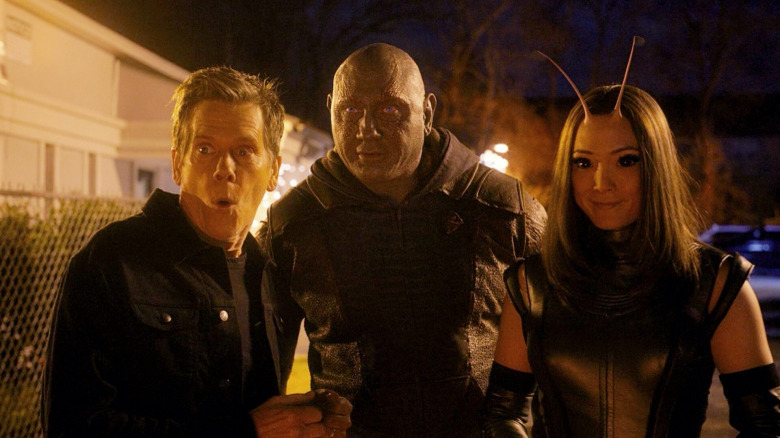
No stranger to Marvel comic book adaptations, Kevin Bacon previously played the former Nazi and head of the nefarious Hellfire Club, Sebastian Shaw, in 2011's "X-Men: First Class." That film, along with the rest of the "X-Men" movies released prior to Disney's acquisition of Fox, takes place beyond the confines of the MCU, so there was never any canonical reason why Bacon couldn't play himself in "The Guardians of the Galaxy Holiday Special." Speaking to Variety, Gunn said that he and Marvel Studios President Kevin Feige never even discussed the idea that Bacon's casting in "First Class" might "preclude" him from joining the MCU:
"One of the things that Kevin Feige has really impressed upon me in running the MCU is that what matters most is the project right in front of him. You may have a plan about how you want to do something down the road, but if it screws up the thing right in front of you, then it doesn't work. The best thing for the holiday special is Kevin Bacon, and if that means that Kevin Bacon is a different character later on in the MCU, it doesn't really matter. It's not real. None of this is real. He was the perfect person to cast as Kevin Bacon. If we had cast John Schneider as Kevin Bacon, it wouldn't have worked as well."
Should Bacon ever sign on to play another MCU character, he would be far from the first actor to tackle multiple roles in the franchise. As for the much shorter list of people who've played themselves in the MCU ... well, let's just say Bacon is readily one of the more reputable individuals to hold that distinction.
"The Guardians of the Galaxy Holiday Special" is streaming on Disney+.
Read this next: The Most Powerful X-Men Characters Ranked
The post James Gunn Was Prepared To Recast Kevin Bacon If He Turned Down The Guardians Of The Galaxy Holiday Special appeared first on /Film.
Universal Flu Vaccine May Be Available Within Two Years, Says Scientist
Read more of this story at Slashdot.
Software Defined Silicon Rides Again, Meet Intel On Demand
2010 was an odd time in many ways, from the first antimatter captured thanks to CERN, to Wikileaks, through kinky Neanderthals, to the Blackhawks breaking their losing streak. It was also…
James Caan Remembered Misery As One Of The Most 'Painful' Films Of His Career
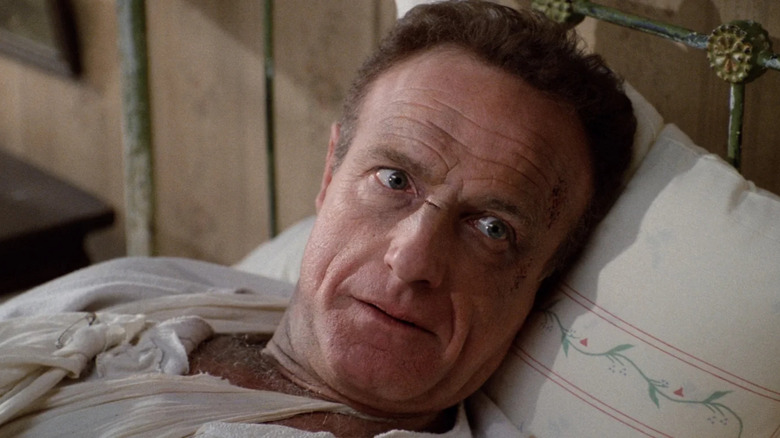
It really should be no surprise that filming a movie called "Misery" was a miserable experience, but actor James Caan was apparently truly tortured making the 1990 Rob Reiner film. Based on the novel by Stephen King, "Misery" is a taut thriller that follows Caan's novelist character Paul Sheldon. Paul gets into a car accident during a blizzard and is "rescued" by his super-fan, Annie Wilkes (Kathy Bates). Annie is obsessed with Paul's books about a woman named Misery, and she doesn't want him to end the series and move on. In fact, she's willing to hold him captive and force him to write her the next Misery novel, even if it means doing some horrible things to keep him under her control.
The role required Caan to lie in bed for the 15-week shoot, which was extremely difficult for the hyperactive actor. He also had to get into some pretty uncomfortable positions in order to create the film's most memorable moment, when Annie hobbles poor Paul with a sledgehammer and a block of wood. Caan wasn't the only one struggling, however, and in an interview with Entertainment Weekly, he and Bates revealed the struggles of surviving "Misery."
'All Of God's Children Got Hurt.'
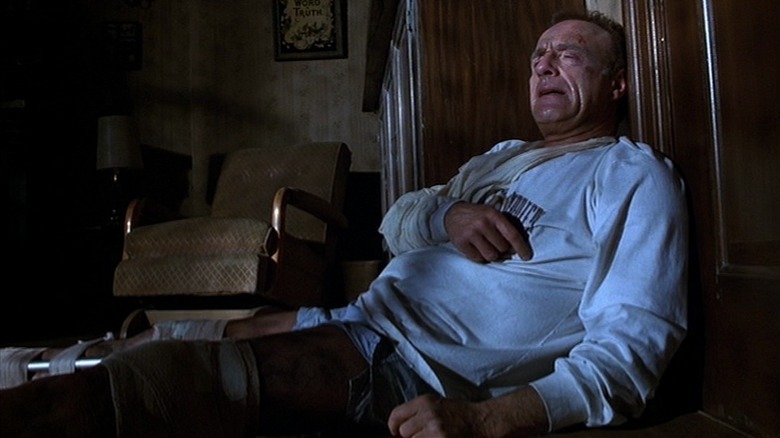
In the interview where Bates and Caan rehashed the making of "Misery," Caan elaborated on why the film was one of the most painful of his entire career:
"By the way, that was one of the most painful shoots... Do you [Bates] remember the shot when you pushed the wheelchair to go back into that glass, and I push myself forward and jump on you, when we get into that fight?... So they said, 'Jimmy, you know, you don't have to go too hard, because the real glass is behind it.' Of course, I oversold it again, boom, and I went into that glass, and on the wheelchair, they had an air gun. And they really fired that sucker, because it had to throw me, you know. But they never put a seat clamp on it, so it slipped out, and it hit me right above the tailbone."
The interviewer pointed out that not only did Caan get hurt, but Bates and the pig performer playing Annie's pet were also injured. Caan replied, "All of God's children got hurt," which is definitely not how filming is supposed to go. Horror movies are notoriously difficult to endure for actors, but injuries are supposed to be few and far between. Thank goodness on-set safety rules have improved since 1990.
Don't Mess With Bates
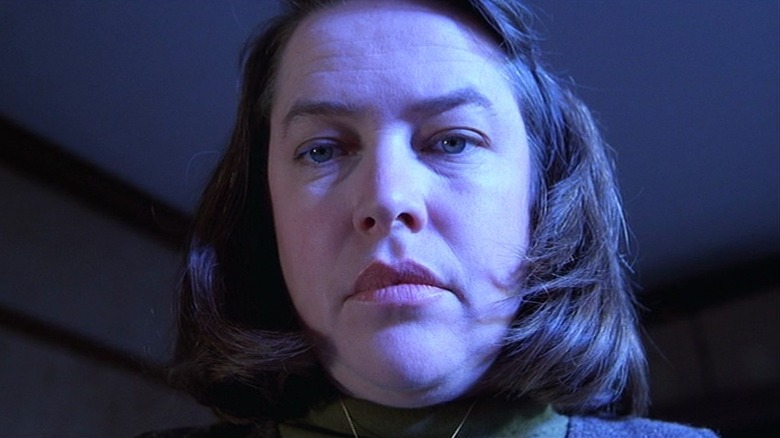
Not content to let Caan get all of the painful glory, Bates chimed in on her experiences during their character's big climactic fight:
"When he slammed my head into the floor and started shoving the paper in my mouth, that was bad. When we got through with that, I just went off stage and burst into tears. It was just awful."
Caan proceeded to tease Bates about being a "little prairie flower" despite playing the absolutely brutal Annie Wilkes, and she wasn't having any of it, responding with a hearty "f*** you." Bates went through hell of her own bringing Annie to life, and making "Misery" was simply miserable for everyone involved, except maybe Reiner. The majority of his problems involved script rewrites, which are significantly less painful than faking a hobbling or a knock-down, drag-out fist fight.
While it's a real shame that "Misery" isn't exactly a happy memory for much of its cast, the result was a brilliant and terrifying film that's one of the all-time best Stephen King adaptations. At least that suffering went towards some great art, and it's not like they got beat up to make "Norbit." Now that would be miserable.
Read this next: All 59 Stephen King Movies Ranked From Worst To Best
The post James Caan Remembered Misery As One Of The Most 'Painful' Films Of His Career appeared first on /Film.
Morrowind’s Tamriel Rebuilt mod now has as many quests as the base game and expansions

Back in the day, I could get lost in The Elder Scrolls III: Morrowind for days, when I could get it to stop crashing anyway. There’s loads more Morrowind in 2022 than I could’ve imagined as a teenager though, as the Tamriel Rebuilt mod project has been working for decades to add other areas of the Elder Scrolls’ provincial mainland into the game. Their latest release, 22.11, landed this week, adding a huge one-two punch of expansions. You can see some of one of those, Dominions Of Dust, in the trailer below.
Marvel’s Spider-Man: Miles Morales November 24th Update improves Ray Tracing & performance, full patch notes
Nixxes has just released the first PC patch for Marvel’s Spider-Man: Miles Morales. According to the release notes, the November 24th Update improves Ray Tracing quality, as well as the game’s performance during cut-scenes. Going into more details, this patch adjusts lighting in cutscenes to match the original game, and improves their performance. Moreover, it … Continue reading Marvel’s Spider-Man: Miles Morales November 24th Update improves Ray Tracing & performance, full patch notes →
The post Marvel’s Spider-Man: Miles Morales November 24th Update improves Ray Tracing & performance, full patch notes appeared first on DSOGaming.
[Steam] (Game) Garfield Kart - Furious Racing
![[Steam] (Game) Garfield Kart - Furious Racing [Steam] (Game) Garfield Kart - Furious Racing](https://external-preview.redd.it/KcHyX-bmompJfTFZfeaaiLk09fckrJywIi_gWR9nnf8.jpg?width=640&crop=smart&auto=webp&s=52c6e495e990f9526cd5fff75951ecdf157cf361) |
submitted by /u/mohsreg_ [link] [comments] |
David Fincher Directed Fight Club Because David O. Russell 'Didn't Get It'

"Fight Club" is a movie people either love or hate. Some viewers are drawn to the nihilistic rants and machismo of Tyler Durden (Brad Pitt), while others are turned off by his constant violence and ramblings about the emptiness of consumerism and society. Chuck Palahniuk, who wrote the novel the film is based on, prides himself on eliciting strong, yet polarizing, reactions through his words. In an interview with The Guardian, he admitted, "I'm fascinated by low fiction that generates a physical response: disgusts the reader, makes them hungry or sexually aroused."
The story of an Ikea-obsessed corporate drone running an underground fighting ring that partakes in breaking and entering and terrorism on the side is a decent premise that might catch an audience's attention, but Palahniuk kicks it up a notch with brutal violence, unabashed sexuality, and unapologetic nihilism. Nothing ruffles feathers quite like the blend of blood, sex, and philosophy, which seems to be exactly what Palahniuk was hoping to do.
When the book was optioned as a film, Hollywood directors also had strong reactions to the story, but they weren't the ones the author intended. According to Brian Raftery in his book "Best. Movie. Year. Ever: How 1999 Blew Up the Big Screen" (via The Ringer), instead of disgust, hunger, or sexual arousal, filmmaker David O. Russell was confused and admitted he just "didn't get it." However, David Fincher connected with the story, and saw it as a "rallying cry" for a disaffected generation.
Fincher Vs Russell
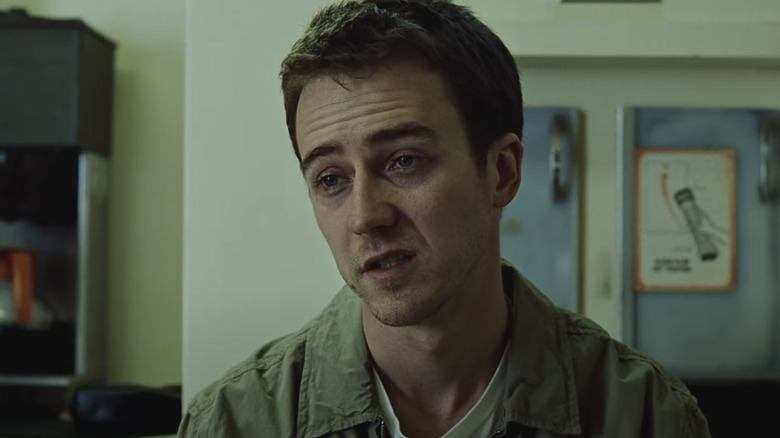
The directors' differences of opinion might come down to the type of films and characters they're drawn to. Russell's filmmaking resumé is full of second coming-of-age stories, where people in their late twenties to thirties experience a cataclysmic event or sudden change that forces them into a new phase of life. To enjoy these films, it's critical for the audience to connect with the characters, and feel the crush of their failures and pride in their accomplishments along with them. There is certainly a place for these movies in cinema, but this isn't the kind of directing style that would have benefited "Fight Club."
While some viewers might enjoy the film overall, it's unlikely that audiences will relate to the main characters. Tyler is entertaining, but also macho and egotistical, and the Narrator (Edward Norton) might actually be worse, since he's whiny, weak, rude, and oblivious. In light of this, it's safe to say that relying on the audience's ability to fall in love with the characters is a one-way trip to failure, which is why it's a good thing Russell passed on the film and left it to Fincher.
Rather than creating an emotional connection between his characters and the audience, Fincher focuses on making his characters' beliefs relatable. Durden isn't a likable character, but that doesn't mean all of his opinions on overconsumption and corporatism are wrong. Likewise, the Narrator comes off as entitled, but it's easy to understand his belief that it's best to blend in with the crowd and live a comfortable life on expensive furniture. Fincher's style of connecting audiences with character's beliefs and opinions is why he was the best choice for "Fight Club."
Plus, he already had experience with shocking endings.
Relating To Tyler's Beliefs
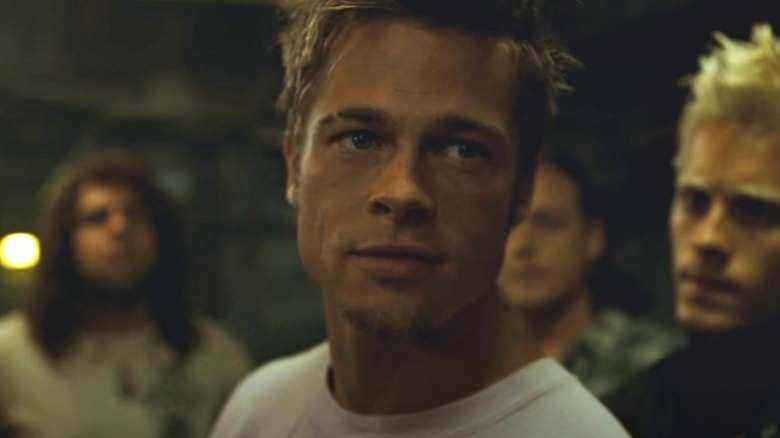
To properly communicate a character's beliefs, the director has to understand them, which is another reason Fincher was the right man for the job. As he explained in the book:
"I was in my late thirties, and I saw that book as a rallying cry. Chuck was talking about a very specific kind of anger that was engendered by a kind of malaise: 'We've been inert so long, we need to sprint into our next evolution of ourselves.' And it was easy to get swept away in just the sheer juiciness of it."
The director related to Durden's resentment and boredom, but Pitt, who gained worldwide fame before appearing in the film, was attracted to the character's thoughts on wealth and consumerism:
"I'm the guy who's got everything, [but] once you get everything, then you're just left with yourself. I've said it before and I'll say it again: It doesn't help you sleep any better, and you don't wake up any better because of it."
Meanwhile, Norton said Durden's beliefs reflected the feelings of entire generations:
"It took aim right at what a lot of us were starting to feel. The book was so sardonic and hilarious in observing the vicissitudes of Gen-X/Gen-Y's nervous anticipation of what the world was becoming— and what we were expected to buy into."
As much as viewers may react to the unsympathetic characters or the violence, sex, and machismo throughout the film, Durden's belief that modern society lacks purpose and is lost in consumerism is the most compelling aspect of the film, which is why Fincher's directing style fit the story perfectly.
Read this next: The 20 Best Dystopian Movies Of All Time
The post David Fincher Directed Fight Club Because David O. Russell 'Didn't Get It' appeared first on /Film.
44 Best Gifts for Dad in 2024
Q3 2022 Discrete GPU Market Share Report: NVIDIA Gains 88% Market Share Hold, AMD Now at 8% Followed By Intel at 4%

Jon Peddie Research (JPR) has published the full GPU market share report for Q3 2022 that cover AMD, Intel & NVIDIA GPUs. While we reported their full GPU market share report a few days ago, today, we will be talking specifically about the discrete GPU numbers which are just as grim as the full PC share report.
Despite Dwindling GPU Shipments, NVIDIA Gains Discrete GPU Market Share Big Time While AMD Falls Below Single-Digit Figures
During Q3 2022, total PC GPU shipments declined by -25.1% (Y/Y) out of which desktop graphics saw a -15.43% decline and notebook graphics saw a -30% decline. This was termed as 'the biggest drop since the 2009' recision by Jon Peddie himself. More on the overall GPU market share here.

So coming to the discrete GPU market share numbers, the report tells us that the dGPU shipments decline to 14 million units versus 24 million units in the previous year. That's a drop of -41.6% & is quite massive if you consider that the third quarter is usually the strongest growth quarter for PCs. During this quarter, NVIDIA managed to raise its market hold to 88%, a record number followed by AMD whose market hold declined to single-digit figures of just 8%. Intel managed to more or less retain its share hold of 4%, witnessing a 1% decline from the previous quarter but a solid 4-5% gain versus the previous year.
The market saw a large uptick in GPU shipments for a brief two-year period all thanks to the crypto craze but it has been on a decline ever since. Currently, the number has fallen before the 100M unit shipments and doing a breakdown, we can see that all segments are mostly down. The desktop & notebook discrete shipments have taken a landslide fall while the desktop and notebook integrated side remains steady and in line with previous years.
If you take a look at the individual desktop and notebook GPU share statistics, the desktop side fared slightly better with a slight increase in shipments from 26 million in the previous quarter to 28 million this quarter. The notebook side saw the biggest drop from 58 million last quarter & 48 million shipments this quarter.
Once again, the desktop discrete GPU market declined to just 7 million units from 10 million in the previous quarter and 13 million in the previous year. Meanwhile, the integrated GPU shipments on desktops boosted from 15% (Q/Q) and 20% (Y/Y) to 21 million in Q3 2022. As of right now, the total PC iGPUs shipment is around 62 Million units while the total PC dGPU shipments are around 14M units.
Unit shipments, segments and vendor share (Credits: JPR)
| Q3 2022 | Desktop | Notebook | Total |
|---|---|---|---|
| Workstation | 0.72 | 1.05 | 1.77 |
| High-end | 2.42 | 4.45 | 6.87 |
| Midrange | 2.78 | NA | 2.78 |
| Entry-level | 0.96 | 1.47 | 2.43 |
| Integrated | 20.78 | 40.85 | 61.63 |
| Total | 27.67 | 47.82 | 75.49 |
GPU Unit Shipments By Segment & Platform in millions (Credits: JPR)
| Q3'22 | Desktop | Notebook | Total |
|---|---|---|---|
| Workstation | |||
| AMD | 0.04 | 0.00 | 0.04 |
| Intel | - | - | - |
| Nvidia | 0.69 | 1.05 | 1.74 |
| High-end | |||
| AMD | 0.13 | 0.20 | 0.33 |
| Intel | - | 0.36 | 0.36 |
| Nvidia | 2.29 | 3.93 | 6.22 |
| Midrange | |||
| AMD | 0.34 | - | 0.34 |
| Intel | 0.26 | - | 0.26 |
| Nvidia | 2.18 | - | 2.18 |
| Entry-level | |||
| AMD | 0.18 | 0.16 | 0.34 |
| Intel | - | - | - |
| Nvidia | 0.78 | 1.27 | 2.05 |
| Integrated | Desktop | Notebook | Total |
| AMD | 2.07 | 5.87 | 7.94 |
| Intel | 18.71 | 34.98 | 53.69 |
| Desktop | Notebook | Total | |
| AMD | 2.76 | 6.23 | 8.98 |
| Intel | 18.97 | 35.34 | 54.31 |
| Nvidia | 5.94 | 6.25 | 12.19 |
| Total | 27.67 | 47.82 | 75.49 |
Both AMD and NVIDIA have been trying to clear their last-gen GPU inventories to make room for next-gen GPUs. While NVIDIA has launched two next-gen products, the GeForce RTX 4090 & the RTX 4080, they are positioned in the ultra enthusiast segment with prices above $1200 US. We've come to know that the green team has shipped over 150,000 RTX 40 GPUs to date and that one of the two GPUs hasn't managed to attract the audience well. The company is still trying to get rid of older RTX 30 series inventory by respinning its mainstream 3060 and 3070 series cards with slightly better specs and promos since the 40 series mainstream cards are a few months away from now.

AMD on the other hand has been doing the same however the ASP for NVIDIA cards is simply a lot higher than the Radeon options at the moment. The company is also on the verge of launchings its next-gen Radeon RX 7000 series cards which are expected to offer better value than NVIDIA's high-end offerings but that remains to be seen. Intel on the other hand just launched its Arc high-end lineup for desktops and will be doing the same for laptops soon. Raja Koduri said that they want to get Arc in millions of PCs every year however the first year for Arc hasn't gone that smoothly. Still, having gained a 4-5% share in a single year is a decent step for the newly formed graphics division.
- AMD Discrete GPU
- AMD Integrated GPU
- Intel Discrete GPU
- Intel Integrated GPU
- NVIDIA Discrete GPU
- AMD (Pre RDNA GPU)
- AMD (RDNA 1/2 GPU)
- NVIDIA (Pre RTX GPU)
- NVIDIA (RTX 20/30 GPU)
- NVIDIA (RTX 40 GPU)
- Intel (Arc GPU)
The post Q3 2022 Discrete GPU Market Share Report: NVIDIA Gains 88% Market Share Hold, AMD Now at 8% Followed By Intel at 4% by Hassan Mujtaba appeared first on Wccftech.
The best tech gifts for $100 or less
It’s dangerously easy to go over budget during the holidays when, especially when your gift list seemingly gets longer with each passing year. It’s even easier to do so when you have a bunch of gearheads in your life. We don’t have to tell you that gadgets are expensive (hello, $1,000-plus smartphones), but not every piece of tech will put a huge dent in your bank account. To make things easier for our budget-minded readers, we’ve collected everything in our gift guide that you can buy for $100 or less here.
You’ll find the full list below, but you can also check out a number of stories in our gift guide this year that include almost all budget-friendly things. Our board games, tech toys for kids and gifts for travel lovers roundups are just a few that are filled with inexpensive yet super fun ideas, plus our annual tech stocking stuffers guide focuses on gifts you can grab for under $50. What we’re trying to say is, you don’t have to go broke to get solid tech for your friends and family; you just have to know which affordable items are actually worth your money.
Audio-Technica M20xBT
Audio-Technica’s affordable wireless headphones have consistently offered solid performance that would make a great gift, even with the lack of noise cancellation. The company’s latest are the M20xBT, a Bluetooth version of the A-T’s popular M20x wired cans. A comfy fit and up to 60 hours of battery life will cost you just $79. Connect to multiple devices at once with Bluetooth multipoint connectivity and reliably control tunes with physical buttons. The design isn’t as refined as the company’s pricer models like the M50xBT2, but you get the bulk of what makes Audio-Technica’s cheaper options so good. — Billy Steele, Senior News Editor
Buy M20xBT at Amazon - $79JLab Go Air Pop
Thanks to JLab, you can give a decent set of true wireless earbuds as a stocking stuffer. For $20, the Go Air Pop covers most of the basics. Eight-hour battery life, on-board controls, EQ presets, IPX4 moisture protection and the ability to use just one earbud at a time are all on the features list. The Go Air Pop is smaller than its predecessor, the Go Air, and this model comes with a case that completely closes. What’s more, the company kept the integrated USB on the charging case, so you don’t have to worry about looking for a cable when you’re out of power. — B.S.
Buy JLab Go Air Pop at Amazon - $25UE Wonderboom 3
If you’re shopping for a Bluetooth speaker this year, the UE Wonderboom 3 is an affordable, tiny option that still packs a punch. It’s adventure-proof thanks to an IP67 rating, audio quality is bright and an outdoor mode boosts treble and bass so sound can be heard over a greater distance. You can also easily pair two Wonderboom 3 units for stereo sound, which won’t cost you a fortune thanks to the low price. And with up to 14 hours of battery life, you should be able to keep the tunes going for a while. — B.S.
Buy Wonderboom 3 at Amazon - $100Roku Ultra
If you're not a fan of the Apple TV, the Roku Ultra is the only other set-top box worth considering. It's fast enough to stream 4K video with Dolby Vision, and it supports just about every streaming app you'd want. It also has a solid remote with voice-search capabilities, and you can still access all of Apple's streaming video via the Apple TV app. And while Roku's interface isn't pretty, it's fast and gets the job done. — Devindra Hardawar, Senior Editor
Buy Roku Ultra at Amazon - $90Joby Gorillapod 3K Flexible Mini-Tripod
One of the most useful accessories out there for vlogger on your Santa list are Joby’s famous mini-tripods, and the best one for the money is the GorillaPod 3K. Attaching your camera couldn’t be easier thanks to the secure clip-in mounting plate with a built-in level. And the flexible legs let you set your camera anywhere to shoot, or even wrap it around a tree or other object. And of course, you can bend them out for the ideal vlogging angle and steady out your shooting, to boot. Best of all, you can now pick one up at Amazon for just $45, a bargain for such a versatile tool. — Steve Dent, Associate Editor
Buy Joby GorillaPod 3K at Amazon - $46Nanlite LitoLite 5C RGBWW Mini LED Panel
A good light is an awesome tool in your favorite photographer or videographer’s arsenal, and a relatively affordable gift to boot. One of the best all-around models is the Nanlite LitoLite 5C RGBWW Mini LED Panel. It weighs just 4.8 ounces, but offers dimmable lighting across a range of colors, with adjustments either on the fixture or via a smartphone app. It mounts on any wall or light stand via a magnet or quarter-inch threads, has cordless operation and a battery that runs for 1.5 hours at full power (charged via USB). The most interesting feature is special effects that range from a cop car’s flashing lights, flames, candlelights, a lightning storm and more. — S.D.
Buy Nanlite LitoLite 5C at Amazon - $75Lexar Professional 1667x 64GB SDXS UHS II card
There’s no point in buying your favorite photographer UHS-I cards anymore when faster UHS-II models can be found at nearly the same price. That’s the case with Lexar’s 64GB or 128GB 1667x V60 UHS-II cards, available at just $33 and $50, respectively. While not as fast as a top-of-the-line 2000x card, you still get faster read and write speeds (250 MB/s and 120MB/s) than any UHS-I card for a fraction of the price. If speed is of the essence, then SanDisk’s top-end V90 cards with 300MB/s read and 260MB/s write speeds can be found for $80 and $150, respectively. — S.D.
Buy Lexar Professional 1667x at Amazon starting at $33AeroPress Go
The AeroPress is a fun way to make a single cup of coffee at home with an apparatus that doesn’t take up much space in the cabinet. It’s a versatile brewer that allows you to experiment with different infusion times and strengths as you go. I like to use it to brew a double-strength cup directly over ice whenever I forget to make cold brew. For the coffee nerd on your list that has a regular setup already, the AeroPress makes a great gift. And the AeroPress Go is even more compact. It tucks neatly inside a cup that you can brew directly into and is perfect for camping and travel. — B.S.
Buy AeroPress Go at Amazon - $40Cuisinart DBM-8
You don’t have to splurge for an Encore in order to get a reliable grinder for the coffee nerd on your list. Before I upgraded, I had a Cuisinart DBM-8 that served me well for years, and it was still doing so when I put it out to pasture. It’s a burr grinder so it provides a consistent grind size with 18 different options to choose from – spanning coarse to fine. The hopper holds eight ounces of beans while the canister can accommodate enough ground coffee for 32 cups. Since you probably won’t need that much often (if ever), there’s a selector that will automatically grind between four and 18 cups worth at the press of a button. — B.S.
Buy Cuisinart DBM-8 at Amazon - $58Cosori Gooseneck Electric Kettle
A good kettle is essential if you want to up your home-brewing game, and it can help make a bunch of other things too like tea, ramen and more. Cosori’s Gooseneck Electric Kettle packs most crucial features into a relatively compact kettle that’s also priced right at $70. Goosenecks can be intimidating but they give you much more control when pouring over a Chemex, and we think Cosori’s, with its matte black finish, also looks pretty nice on most countertops. It has a stainless steel interior and five presets so you can easily get the perfect temperature for things like green tea, black coffee and more. Plus, the “hold temp” option lets you set and forget the water for a bit; you can turn it on before you start your morning routine and come back to perfectly heated water, ready for whatever’s picking you up that morning. — Valentina Palladino, Senior Commerce Editor
Buy Cosori electric kettle at Amazon - $70BruMate NAV mini
When it comes to travel mugs for coffee and tea, any item worth considering needs to check a few boxes – especially if you’re giving one as a gift. Being able to keep liquids hot for a few hours and fit in a cup holder are essential. BruMate’s NAV mini does both, and at 12 ounces, it’s the perfect size for on-the-go joe. Plus, it’s 100 percent leak proof thanks to the company’s robust lid. It can also keep cold drinks chilled for over 24 hours when that certain someone on your list needs cold brew next summer. — B.S.
Buy NAV mini at BruMate - $25Stanley Classic Neverleak travel mug
If you know someone that needs to keep coffee hot for much longer than a typical travel mug, Stanley’s Classic Neverleak option is the perfect gift. I’ve been using one of these for well over a year and it does an incredible job at keeping liquids at temperature for a long time. The company says your drink will still be warm for up to nine hours, plus the entire thing is dishwasher safe for easy cleaning. The three-position lid also locks closed to prevent accidental spills even if the mug gets jostled around. — B.S.
Buy Stanly Neverleak mug at Amazon - $28Miir cold brew filter + Wide Mouth bottle
There are a million ways to make cold brew, but it doesn’t get much easier than adding a stainless steel filter to your insulated travel bottle. Miir’s cold brew filter works with some of its drinkware canisters to provide a cold brew setup with “micro perforations” to reduce sediment after steeping. The filter fits Miir’s 32- and 42-ounce Wide Mouth Bottles (and 33oz Tomo) for plenty of smooth, cold coffee for adventures or taking to work. Plus, those Bottles have a leak-proof lid and can keep drinks hot or cold for hours. — B.S.
Buy cold brew filter at Miir - $15Fellow Prismo AeroPress attachment
The AeroPress is a versatile brewing device and that’s why we keep it on your coffee gift guide list. But with the help of Fellow’s $30 attachment, you can take the humble method up a notch. The Prismo houses a pressure-actuated valve designed to mimic the process of making espresso so you can “pull a shot” without a machine. This creates the “crema” that you don’t typically get just by brewing stronger coffee with the AeroPress alone. The Prismo also comes with a reusable filter so you’re not burning through the paper ones an AeroPress usually requires. — B.S.
Buy AeoPress attachment at Fellow - $30Hiware Borosilicate glass pitcher
After the handle on my previous pitcher developed a crack, I went on a search for a simple but durable container that could support my iced tea addiction and after a year and a half, this thing has not disappointed. Its heat-resistant borosilicate glass means you can pour boiling water directly into the pitcher without worrying about it shattering and its huge 68-ounce capacity holds enough to keep an entire family hydrated. Meanwhile, the stainless steel lid prevents leaves or stuff like fruit pulp from escaping. And at $20, this pitcher is just great value. — Sam Rutherford, Senior Reporter
Buy Hiware glass pitcher at Amazon - $27Hario Cold Brew Bottle
If you know someone who always brings their “famous” iced tea to parties or picnics check out Hario’s Cold Brew bottle. It holds up to 750ml of liquid and comes with a removable strainer to keep tea leaves from spilling out. There’s even a grippy silicone top for easy handling and a removable stopper that acts like a cork. And if you’re worried it’s a little pedestrian looking to make a lasting impact, Hario makes a champagne bottle version too. — S.R.
Buy Hario Cold Brew Bottle at Amazon - $24Breville IQ Electric Kettle
For those on your list that prefer function over form, you really ought to consider Breville’s IQ Electric Kettle. In addition to having nearly double the capacity (57 ounces vs 30 ounces) of the Stagg, it has dedicated temperature settings for a lot of major types of tea (green, white, oolong and black). It’s also a bit more powerful with an output of up to 1,500 watts, so there’s less waiting around for the water to heat up. — S.R.
Buy Breville IQ electric kettle at Amazon - $80OXO Tea Infuser Basket
One of the easiest ways to brew better tea is by moving away from single-serving bags and switching to loose-leaf teas. That’s because typically tea bags feature lower quality leaves that often sit on shelves for months (or years) with the whole process favoring convenience over flavor. On top of that, the cloth or (more often) paper used to make tea bags can also impart unwanted flavors.
If you know someone looking to get into loose-leaf teas, they’re going to need an infuser, and OXO’s is one of the best. Its stainless steel basket won’t mess with the taste and its included lid traps heat in when steeping while also doubling as a saucer to prevent dripping once the tea is ready to drink. The basket is also a perfect size so it fits in practically any mug (and even many iced tea pitchers), and at just $15, it’s cheap enough to buy two or more so there will always be a clean one ready to go. — S.R.
Buy OXO tea infuser basket at Amazon - $15Fellow Atmos Vacuum Canister
While Fellow’s Atmos Canister was originally intended to store coffee, it’s equally great at keeping tea tasting fresh and flavorful, even after long periods. That’s because simply twisting its lid removes oxygen from the canister, slowing down potential oxidation which can cause tea to taste dull and lifeless. It’s available in three sizes (0.4, 0.7 and 1.2 liters) and in a range of materials, though you’ll probably want to stay away from the glass version, as light is another source of potential oxidation. (Leave the clear one for cookies or something.) And while it’s a bit on the pricey side, in my opinion there’s no better way of keeping even the fanciest leaves tasting great over time. — S.R.
Buy Fellow Atmos canister at Amazon - $35Golde Superwhisk
For matcha lovers who don’t want to deal with the hassle of a traditional bamboo whisk or anyone seeking a way to quickly froth up some milk, Golde’s Superwhisk is a great pick. It has two different speed settings and a battery that can be recharged via USB. It even comes with an included travel case, so your giftee can take it camping or anywhere they want to enjoy some tea (or a latte). — S.R.
Buy Superwhisk at Golde - $24Pure’Tea Portable Tea Infuser
For people who want to bring their brew on the go, this charming portable tea infuser bottle looks great and makes the whole process super easy. Tea goes in the top section and water goes in the bottom. Right before drinking they flip the whole infuser upside down to brew instead of letting the leaves become oversteeped after sitting in water all day. The portable infuser also features borosilicate glass with a double-walled construction, so it can handle high temperatures without burning hands. Admittedly, there are similar bottles for less, but between its innovative design and premium materials, I can’t think of a better way to drink tea on-the-go. — S.R.
Buy portable tea infuser at Perlure - $65Breakaway Matcha Flight Kit
Getting into matcha can be intimidating for even long-time tea drinkers. Not only can matcha be expensive but, since it’s very finely ground green tea instead leaves steeped in water, it has a very different flavor profile and texture. So instead of buying someone a single type of matcha, give this matcha flight kit a try. It includes four different blends which range from bright grassy varieties to deeper savory mixes. There’s also a handcrafted bamboo scoop, a sieve, tea towel and most importantly, a motorized whisk for properly whipping up the perfect cup. — S.R.
Buy Flight Kit at Breakaway Matcha - $56Adagio Tea Samplers
For complete newbies to tea, Adagio’s loose teas sampler sets offer a huge range of types and flavors to choose from. You can select specific types like green teas from China for the Sinophile on your list, or opt for more general mixes like seasonal blends or even herbal selections. Prices also start as low as $12 a box for four different types, which makes this one of the most flexible and affordable ways of gifting a wide range of teas without doing a ton of research. — S.R.
Shop Adagio tea samplersButterfly Pea Tea
The first time I had butterfly pea flower tea was on my honeymoon in Thailand and it was love at first sip. It has a sweet flora aroma with some subtle earthy notes. But its signature highlight is its color. When brewed alone, you get a deep blue hue with hints of green, but when you add acid suddenly the tea becomes bright purple or pink. And because butterfly pea flower doesn’t contain caffeine, between its color and taste, it’s a great way to introduce kids to tea. Steep it, chill it, add the juice from a couple lemons or limes and a splash of sugar (I preferred agave), and in no time you’ll have the perfect summertime iced tea. — S.R.
Buy butterfly pea tea at Amazon - $22Astro A10 Gen 2
Astro’s A10 Gen 2 will get the job done and look cute while doing so, no matter what your personal style is. The Gen 2 comes in a variety of colors and patterns, from deep black with neon details to pastel purple or teal, meaning there’s something for every kind of live streaming vibe. It has a flip-to-mute boom mic, an incredibly flexible body, and replaceable ear pads and headband cushion. This headset is compatible with PC, Mac, PlayStation 5, Xbox Series X/S and Switch, so have at it, no matter how you play. — Jessica Conditt, Senior Reporter
Buy Astro A10 Gen 2 at Amazon - $608bitdo Pro 2 Bluetooth controller
8bitdo knows its way around a wireless gamepad, and the Pro 2 Bluetooth controller is no exception. Whether in the transparent-body special edition or the classic black, white or gray, the Pro 2 delivers precise inputs, support for up to three custom profiles, and two extra back buttons. The Pro 2 looks like an old-school controller but it has advanced, modern capabilities, and it works with PC, Mac, Android and Switch. — J.C.
Buy 8BitDo Pro 2 at Amazon - $50Logitech Litra Glow
The best thing you can do for your live-streaming setup is to get some good lighting, and Logitech’s Litra Glow has you covered. This is a small, mountable LED square that delivers a diffuse, soft glow without any harsh shadows or defined edges, and it’s designed to make its subjects look their best. It comes with an extendable three-way monitor mount and is USB-powered. — J.C.
Buy Litra Glow at Amazon - $60Wanxing neon signs
Nanoleaf may be the premier brand when it comes to live-stream lighting, but there are plenty of other, cheaper options in the realm of on-screen glow. Wanxing, for instance, has a line of neon signs that’ll make any streaming space pop, at prices that won’t bust your budget. There are plenty of designs to choose from, including skulls, hearts, ghosts, game controllers and cute text, each available for less than $40. — J.C.
Shop Wanxing neon signsGoogle Nest Hub (2nd gen)
Google’s Nest Hub smart display is a great device to have around the home — especially if your gift recipient already uses the Google Assistant. It works as a digital photo frame and they can use it to watch YouTube and Netflix. It can also make calls via Google Duo and offers recipe videos along with step-by-step cooking instructions. If the user so chooses, they can track their sleeping patterns if they place the device next to their bed. Additionally, if they already have a Nest Doorbell camera, they can easily use the display to see who’s at the front door. — Nicole Lee, Commerce Writer
Buy Nest Hub at B&H - $100Blink Indoor camera
Blink’s indoor camera offers the gift of peace of mind in a compact and affordable package. Your loved one will appreciate the fact that Blink is wireless and battery-powered; since they don’t have to place it near an electrical outlet, it can sit almost anywhere. They also won’t have to worry about recharging the camera since it can last up to two years on its two included AA batteries. Aside from just letting them monitor their home, it also features customizable motion alerts so they’ll only get alerted when they want to. There’s also two-way audio so they can hear and speak to the person (or pet) on the other end. — N.L.
Buy Blink Indoor at Amazon - $80TP-Link Kasa smart plug
With a smart plug, any appliance can be part of a connected home for not a lot of money. TP-Link’s Kasa smart plug is a particularly good one because it is both affordable and incredibly compact (and if you’re really short on space, there’s a mini version that’s even smaller). Together with its companion app, they can schedule a timer to turn on and off anything from Christmas lights to a coffee maker. It’s also compatible with both Alexa and Google Assistant, which lets them add voice control to any outlet. — N.L.
Buy Kasa smart plugs at Amazon - $30Eero 6 WiFi Mesh router
With most of us having so many gadgets and smart home devices, perhaps the best thing you can give your loved one is the gift of better WiFi to keep things running smoothly. Amazon’s Eero routers will deliver just that. The latest models support WiFi 6, the latest and fastest WiFi standard, and will support 75-plus devices simultaneously. It also covers up to 1,500 square feet with WiFi speeds up to 900 Mbps, so it’s unlikely they’ll ever have to deal with dead spots or buffering again. The Eero 6 also comes with a built-in Zigbee smart home hub that lets them connect compatible devices without having to purchase a separate device. — N.L.
Buy Eero 6 at Amazon - $89Startorialist JWST Cosmic Cliffs High Top Sneakers
JWST has been fully operational since June 2022, and it’s already sent us stunning images of our universe. One is a star-forming region in the Carina Nebula called the Cosmic Cliffs (fun fact, the tallest peaks are 7 light years high!) and you can get this amazing image on a classy pair of high-top sneakers from Startorialist, a STEM fashion brand. Keep in mind these are a custom order, so they may take a few weeks to ship. — Swapna Krishna, Freelance Writer
Buy Cosmic Cliffs sneakers at Startorialist - $89Banllis Decorative Astronaut and Moon Bookends
Want to spruce up someone’s book shelves? These adorable astronaut moon bookends will delight any space lover. They come in two colors, gold and gray – depending on whether you want them to pop or blend in. They aren’t the heaviest bookends, so you probably don’t want to hold up a huge stack of hardcovers with these, but they look good from both far away and close up – the detailing on the moons is an especially nice touch. — S.K.
Buy bookends at Amazon - $47The Milky Way: An Autobiography of Our Galaxy
Moiya McTier tells the story of the Milky Way in a unique way: from the point of view of the galaxy. It’s a funny and smart look at our galaxy (and humans’ place within it), and presents scientific information in an approachable and often hilarious way. Whether you’ve read every space book out there and are looking for something new or don’t know where to start, this is a unique perspective for sure. — S.K.
Buy The Milky Way at Amazon - $14Four Point Puzzles Moon Puzzle
This 1,000 piece puzzle features an exquisite NASA image of the Moon’s surface. The rich detail here, and the intricate lunar features, will provide a challenge to even experienced puzzle aficionados. — S.K.
Buy moon puzzle at Four Points - $28Svaha USA JWST Deep Field Custom Hoodie
Svaha USA is another great brand that’s got some fantastic STEM merch. They’ve even got JWST’s Deep Field image of galaxy cluster SMACS 0723 on a hoodie! If a pullover hoodie isn’t your thing, you can also find the image on tote bags, dresses, and more. These are custom printed upon ordering, so don’t wait until the last minute or you may not receive yours by the holidays.
Buy at custom hoodie at Svaha - $60Astronomy Activity Book For Kids
If you have five to seven year old kid on your holiday gift list who’s fascinated by galaxies far away, this activity book is a great choice. Written by a former NASA scientist and beautifully illustrated, it contains games and projects about space, information on how to find constellations and big astronomical events such as meteor showers, and more.
Buy Astronomy Activity Book at Amazon - $9Super Cool Space Facts
If the kid on your list is more into cool facts and less into hands-on projects, this book is exactly what you think it is from the title: full of hundreds of space facts, along with full-color photos. It’s a great choice for any younger space nerd – but honestly, it’s a good read for the adults in your life who want to know more about space but don’t know where to start.
Buy Super Cool Space Facts at Amazon - $8Sony MDR-7506
Every music lover and music maker needs a good pair of headphones. There are so many amazing sets out there to choose from, but I remain a dedicated fan of Sony’s affordable workhorse the MDR-7506. They’ve been a studio mainstay for decades for good reason. They’re natural sounding, light and comfortable enough to wear for hours, and reasonably priced. The MDR-7506s are equally at home monitoring a podcast, mixing a club banger or just listening to some vinyl. In short, they’re a great practical gift even if you’re operating under a tight budget. — Terrence O'Brien, Managing Editor
Buy Sony MDR-7506 at Amazon - $100Oblique Strategies
Anyone who practices some sort of creative art – be it music, painting or writing – hits a block at some point. There’s tons of advice out there on how to overcome these hurdles, but one of the most famous is easily the Oblique Strategies deck. Developed by Peter Schmidt and Brian Eno in 1975, each card contains an action or a way of thinking designed to shake up your approach to a thorny creative problem. “Use an unacceptable colour,” “Make a sudden, destructive unpredictable action; incorporate” and “Emphasize the flaws,” are the sorts of vague instructions you can expect. And how someone interprets the prompts will produce different results for each person. If you’re shopping for anyone with a creative streak, they’ll find a use for this deck. — T.O.
Buy Oblique Strategies at Eno Shop - $60Dilla Time
If you’re gift shopping for a music producer I can almost guarantee you they’re fans of J Dilla. He was a singular force in hip-hop, and has even had his MPC displayed at the Smithsonian. Dilla Time by Dan Charnas chronicles not just the life of Dilla (James DeWitt Yancey), but his legacy and the history of rhythm in America. In addition, there are graphics that help illustrate the concepts behind Dilla’s unique beats and what made him so special. It’s part biography, part history lesson and part practical music production guide. — T.O.
Buy Dilla Time at Amazon - $22How to Write One Song
If there’s an aspiring songwriter on your list, consider picking them up a copy of How to Write One Song. Written by Jeff Tweedy of Wilco, this tome breaks down the process from beginning to end and encourages readers to start small; don’t try to become a “songwriter” just try to write a song. But this isn’t a rote how-to book, that sort of thing is only so helpful when it comes to mastering an artistic craft. It’s about building creativity into your everyday life. And just like any other skill, being creative requires practice. — T.O.
Buy How to Write One Song at Amazon - $19Blood, Sweat, and Pixels
Blood, Sweat, and Pixels is a must-read for anyone with even a passing interest in video games. Across 268 captivating pages, Bloomberg journalist Jason Schreier shares how some of the most influential games of the past decade were made. Featuring interviews with the people who were there – including The Last of Us director Neil Druckmann and Eric Barone, the creator of Stardew Valley – the stories that populate Blood, Sweat, and Pixels shed a light on just how fraught the process of creating a game can be during even the best of times. It’s riveting reading for anyone who wants a more informed perspective on the craft. — Igor Bonifacic, Weekend Editor
Buy Blood, Sweat and Pixels at Amazon - $14Logitech G305
Don’t let the Logitech G305’s affordable $40 price fool you, it’s a gaming mouse almost any gamer would happily add to their collection. At 99 grams, it’s one of the lighter mice in Logitech’s stable, and you can program all six buttons to your liking. It also includes the company’s fast and responsive Hero optical sensor and Lightspeed wireless technology for “wired-like” performance. A single AA battery provides the G305 with up to 250 hours of life, and you can get as much as nine months of use with some tweaking. Best of all, the G305 is available in a few different colors, including a handful of cheerful pastels. There’s even a K/DA version for fans of Riot’s virtual K-pop group. That versatility makes a perfect gift for a PC gamer. — I.B.
Buy Logitech G305 at Amazon - $50Backbone One
If you’re buying a gift for someone who primarily plays games on their phone, consider treating them to the best mobile gamepad on the market. At $100, the Backbone One is pricey, but it easily surpasses competitors like the Razer Kishi in build quality. It also comes with a surprisingly robust companion app tha...
The Callisto Protocol PC System Requirements Revealed

The Callisto Protocol’s release is nine days away. The game's Season Pass also revealed some other information about it, including some of its future content like a new difficulty and 12 more unique death animations. Today’s update is centered on what users need to run the game. Without further ado, let’s get to it.
Visiting the game’s Steam page allows you a few options: pre-ordering the game, pre-ordering the Deluxe Edition, or viewing the game’s PC requirements towards the bottom of the page. The following is what you’ll need to run The Callisto Protocol:
- OS: Windows 10/11
- Processor: Intel® Core
 i5-8400 or AMD Ryzen
i5-8400 or AMD Ryzen 5 2600
5 2600 - Memory: 8 GB RAM
- Graphics: NVIDIA® GeForce® GTX 1060 or AMD Radeon
 RX 580
RX 580 - DirectX: Version 11
- Storage: 75 GB available space
- Note: Requires a 64-bit processor and operating system
Meanwhile, the game’s recommended specifications are as follows:
- OS: Windows 10/11
- Processor: Intel® Core
 i7-8700 or AMD Ryzen
i7-8700 or AMD Ryzen 5 3600
5 3600 - Memory: 16 GB RAM
- Graphics: NVIDIA® GeForce® GTX 1070 or AMD Radeon
 RX 5700
RX 5700 - DirectX: Version 12
- Storage: 75 GB available space
- Additional Notes: SSD recommended, and requires a 64-bit processor and operating system
So, that’s what you’ll need to play The Callisto Protocol. All things considered, the game’s looking to be quite a strong outing for Striking Distance Studios, but only next week can tell how the game will be at launch. For the time being, though, we’ll continue to update as more information on The Callisto Protocol is released, including DLC, gameplay updates, and more.
The Callisto Protocol will launch on December 2nd, 2022, for PlayStation 5, PlayStation 4, Xbox Series, Xbox One, and PC via Steam and the Epic Games Store. Pre-orders for the game are available right now. In other news, we just saw Rockstar impose a huge ban on NFTs in Grand Theft Auto Online and Red Dead Online. This news also comes with a statement from the company.
The post The Callisto Protocol PC System Requirements Revealed by Ule Lopez appeared first on Wccftech.

